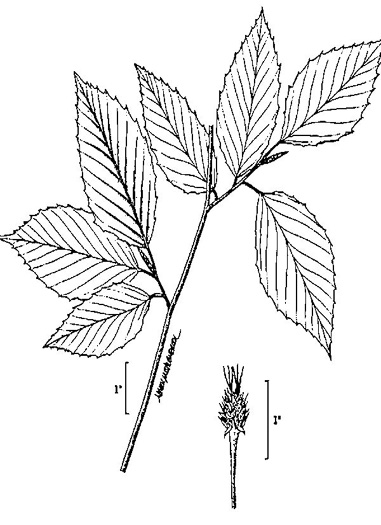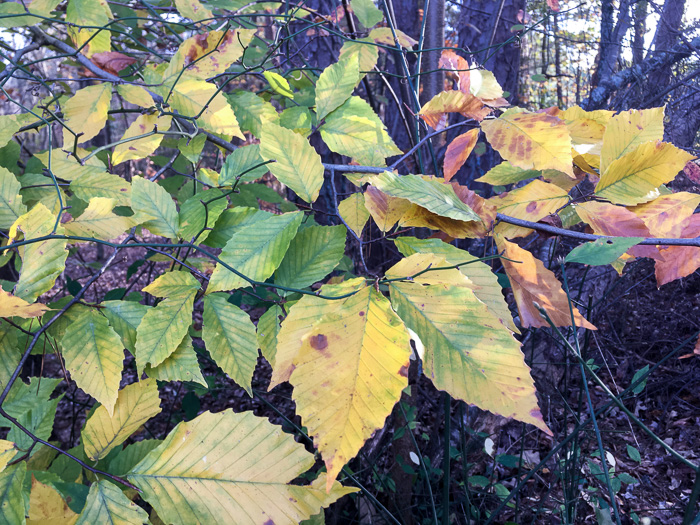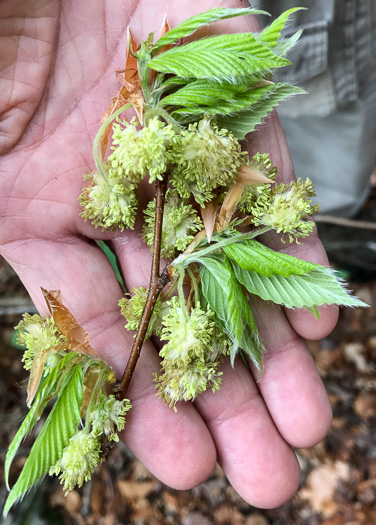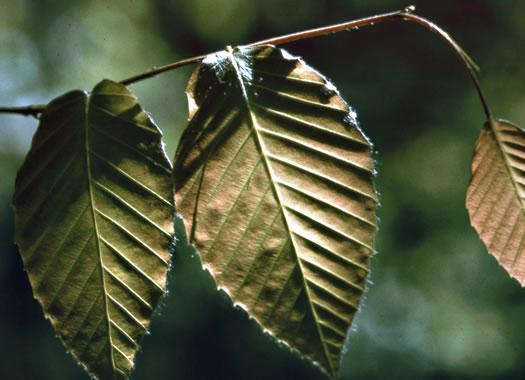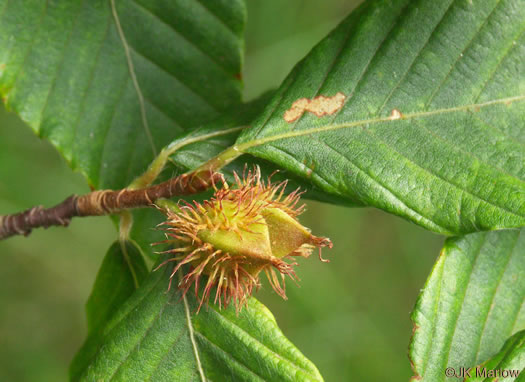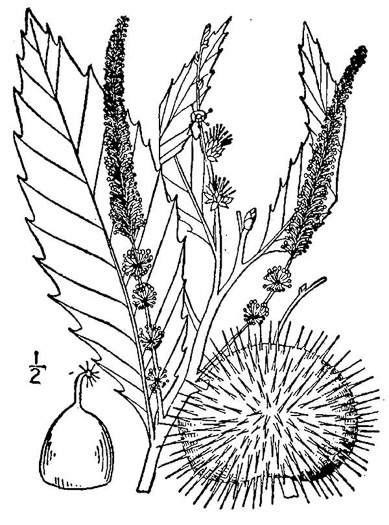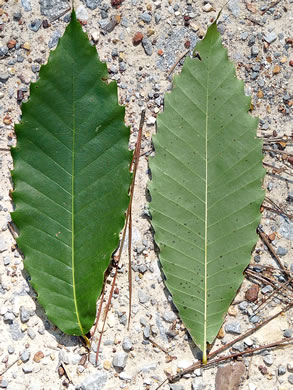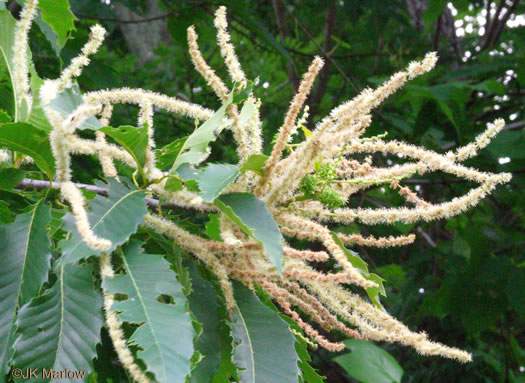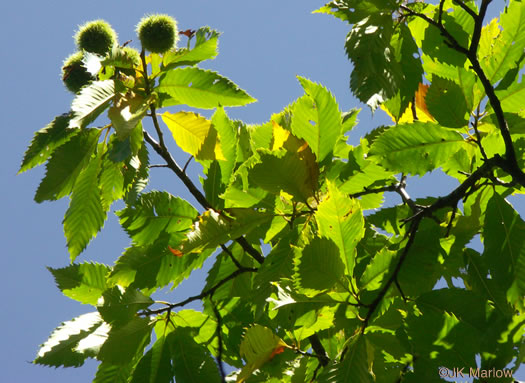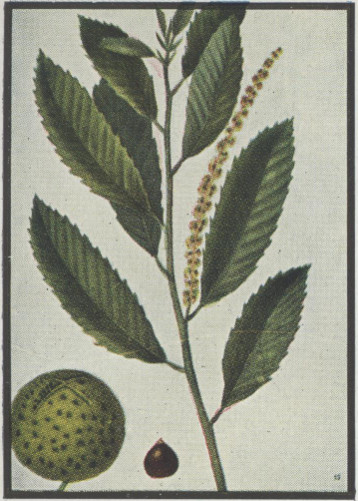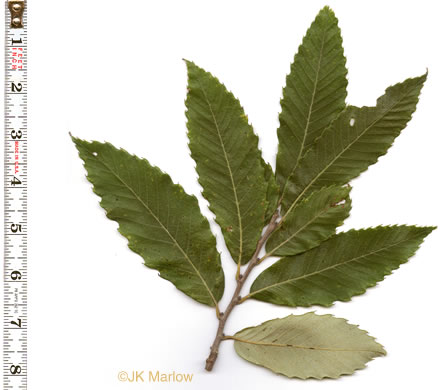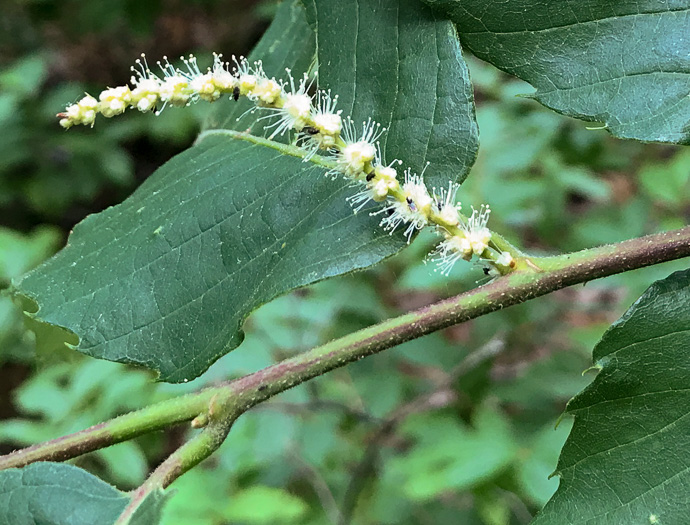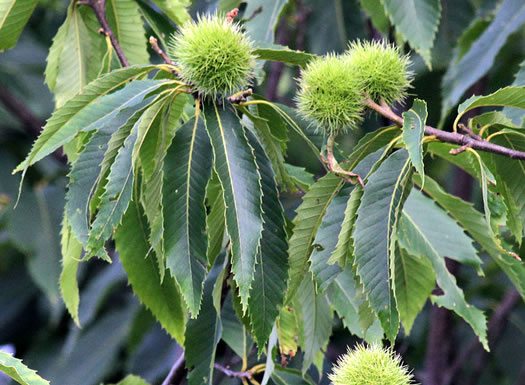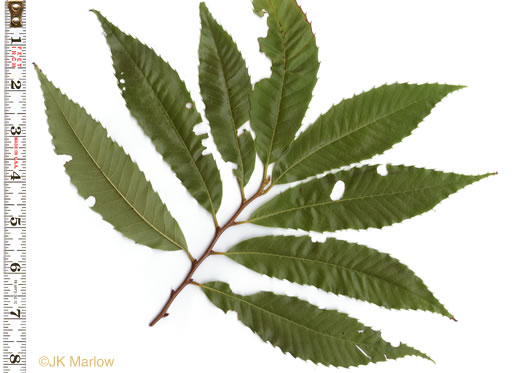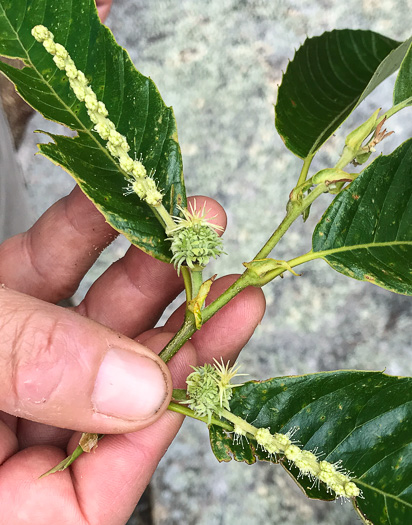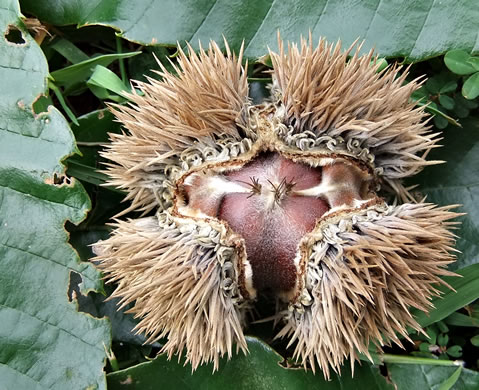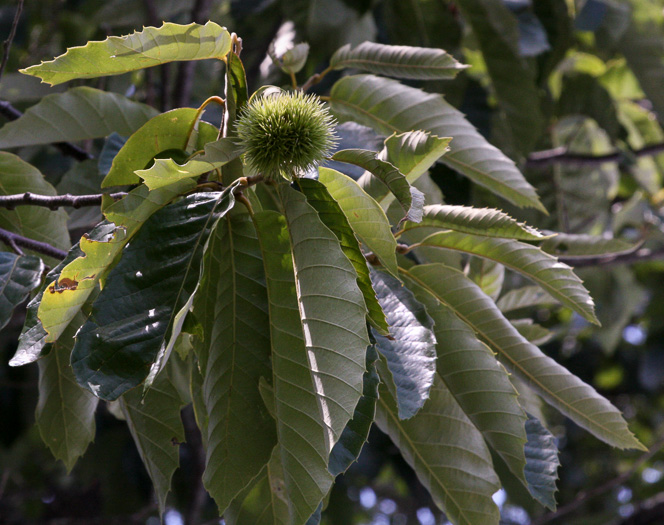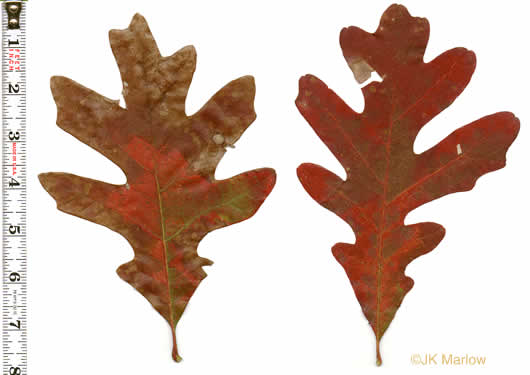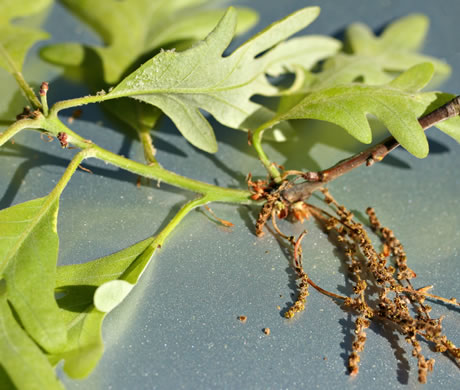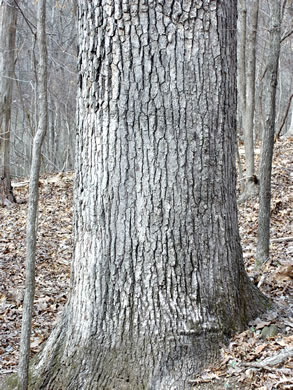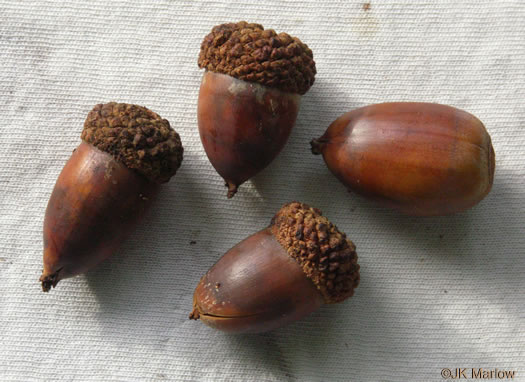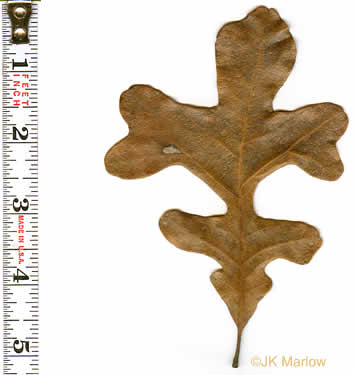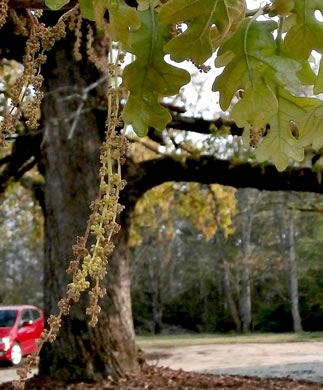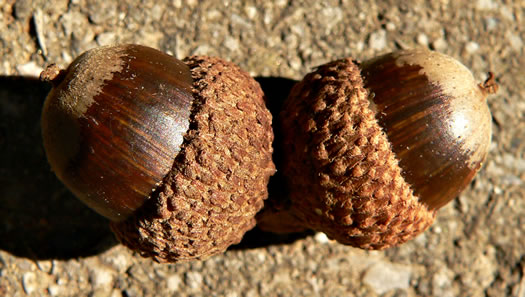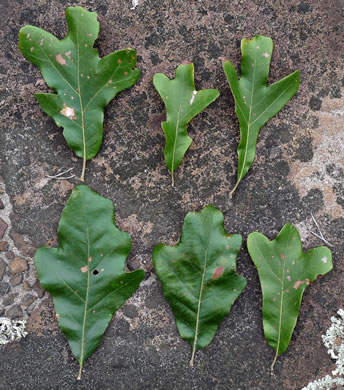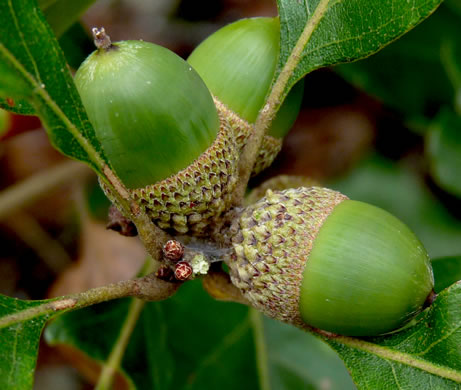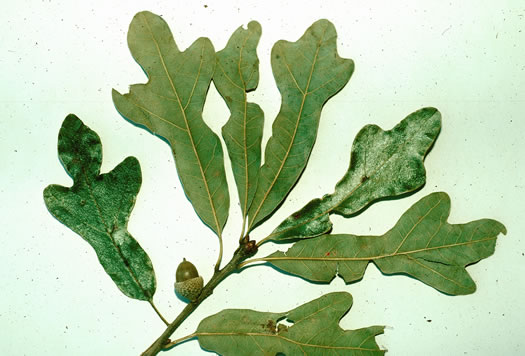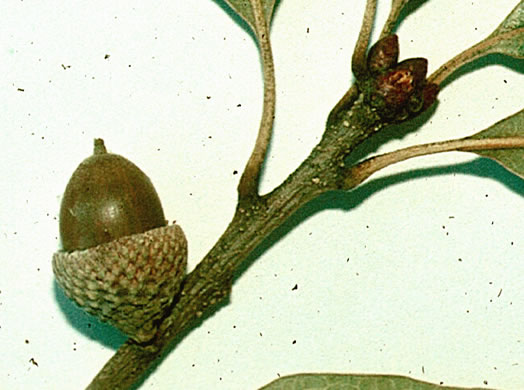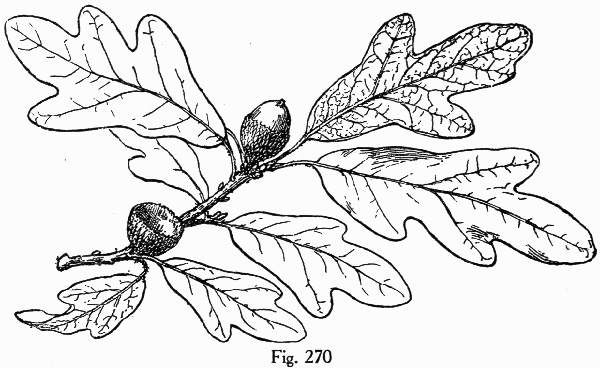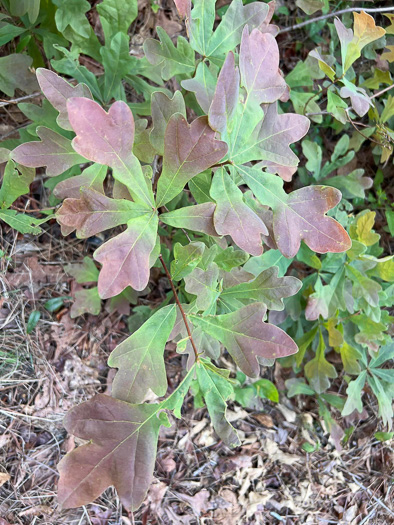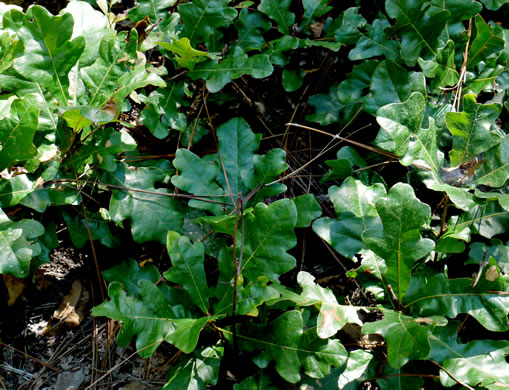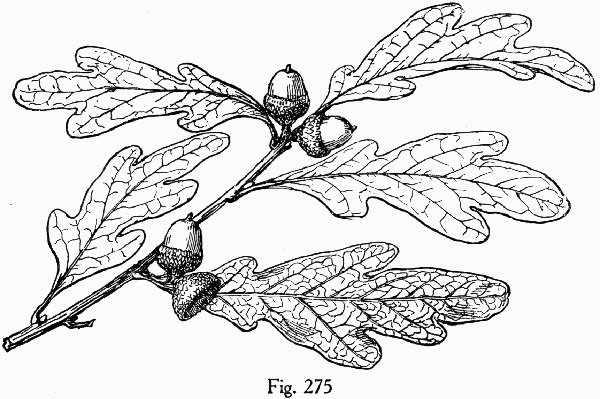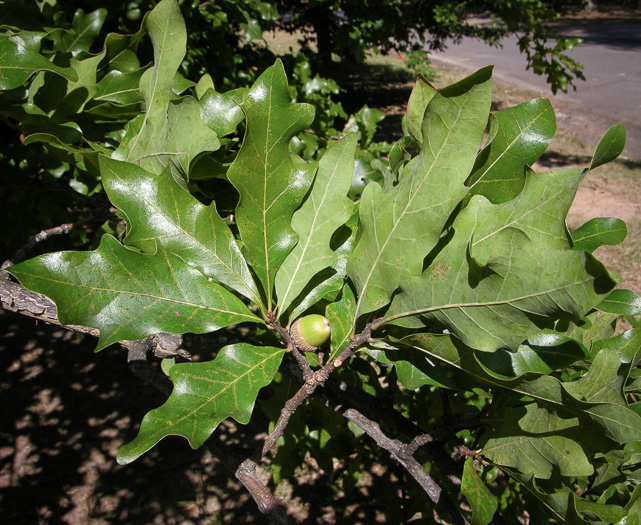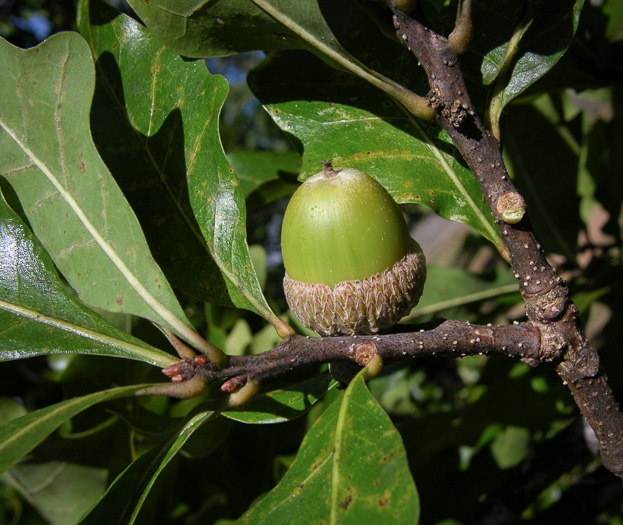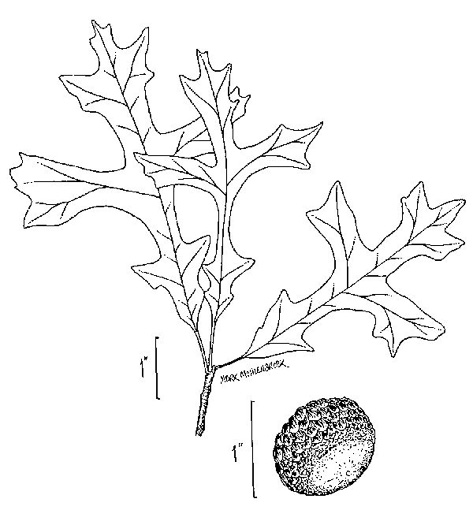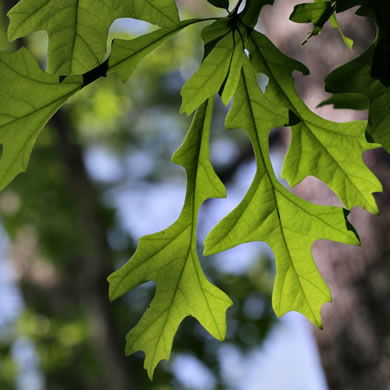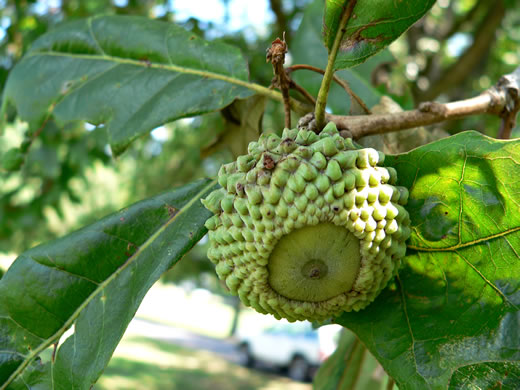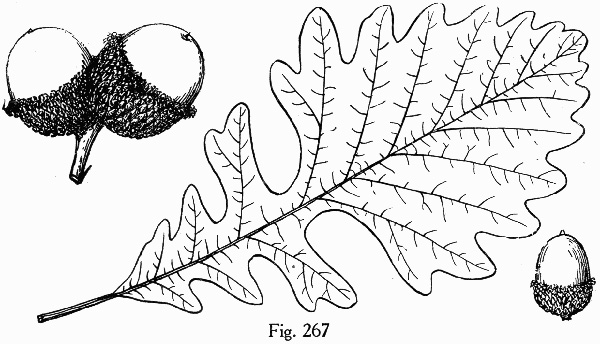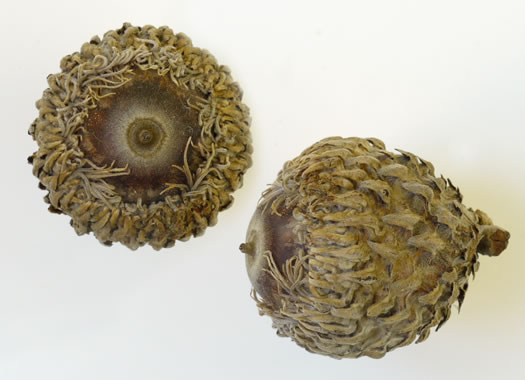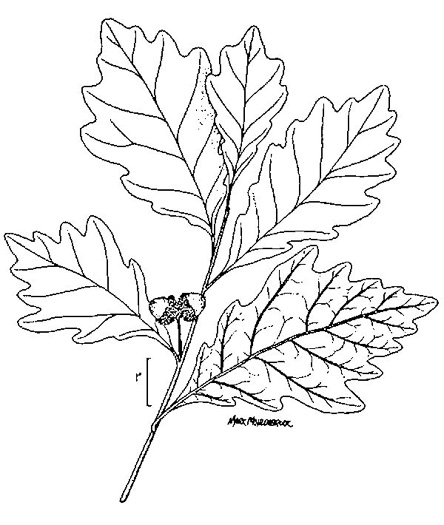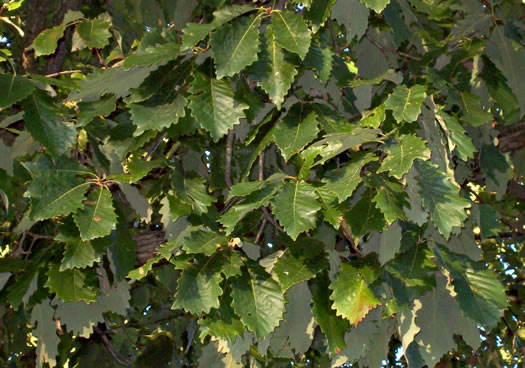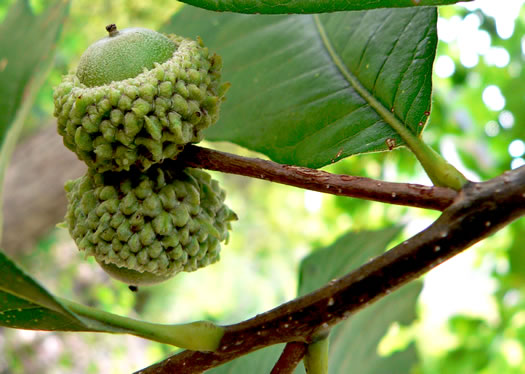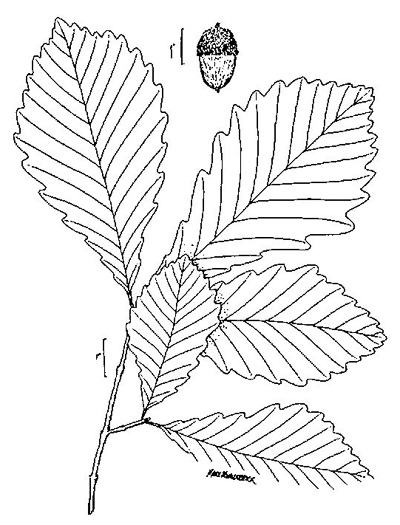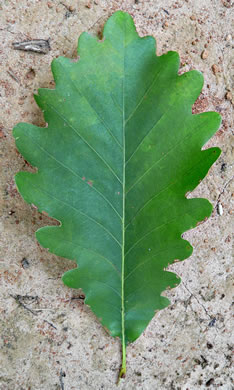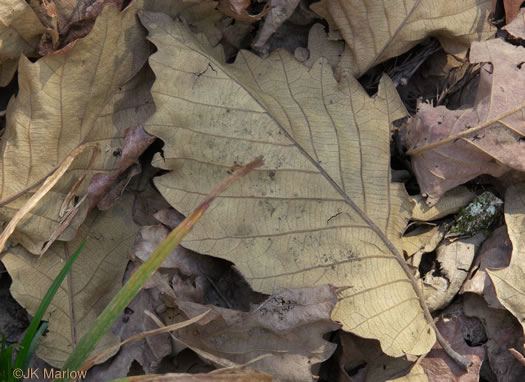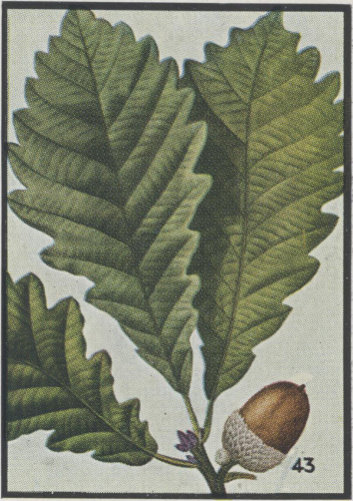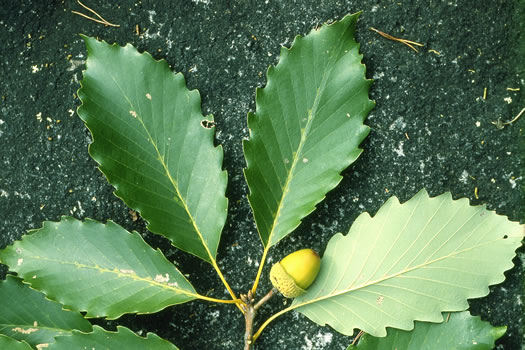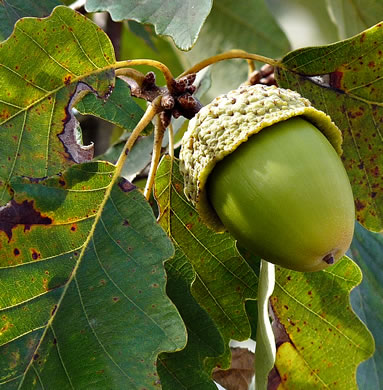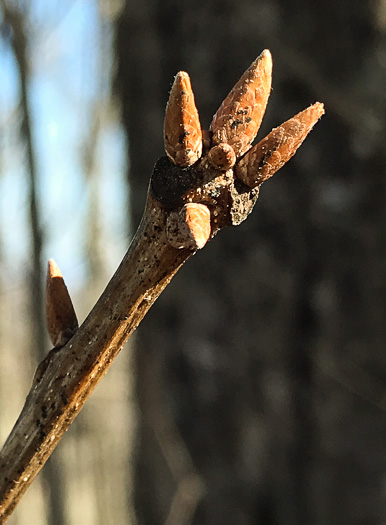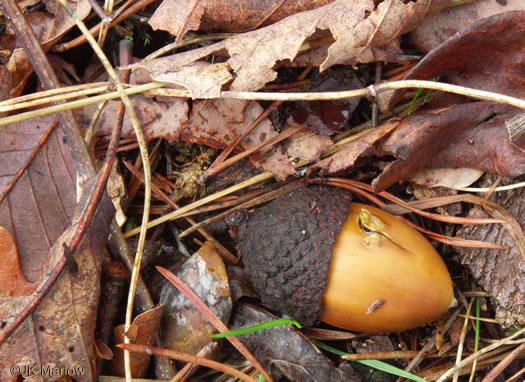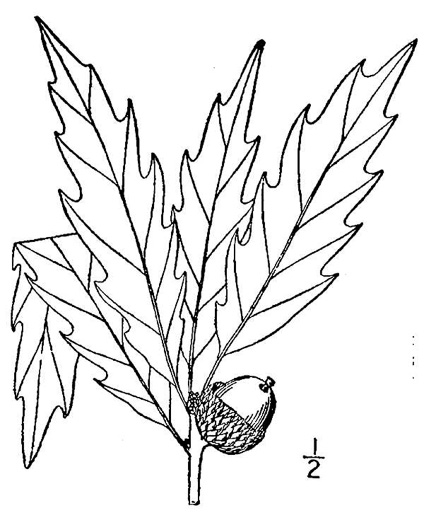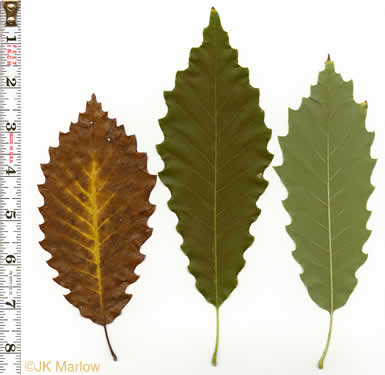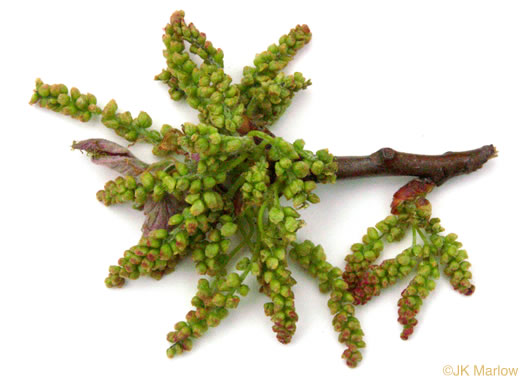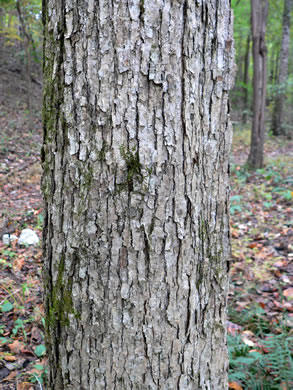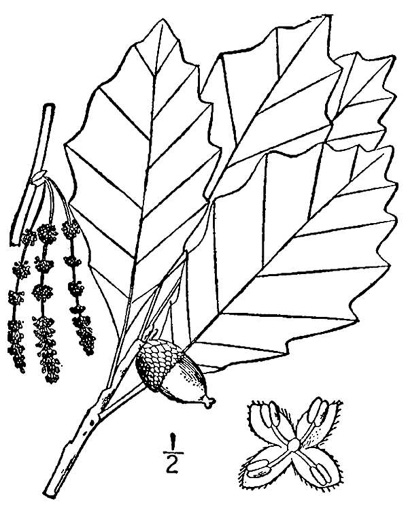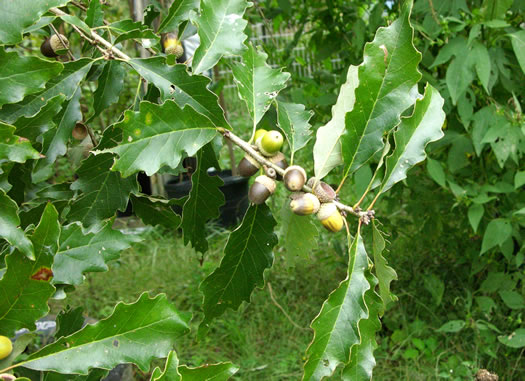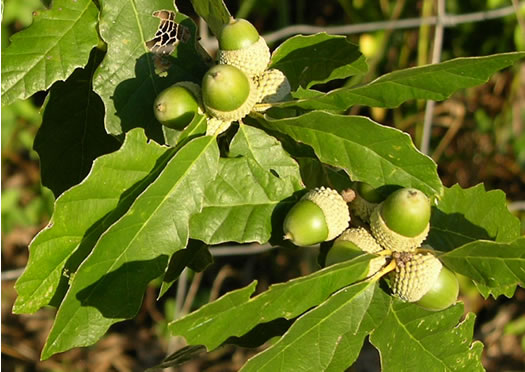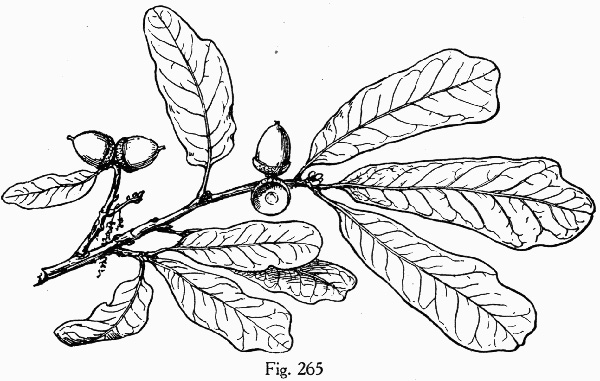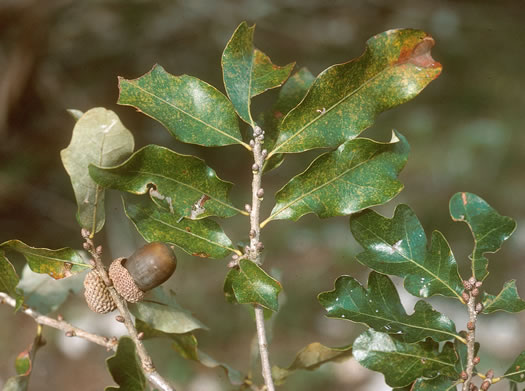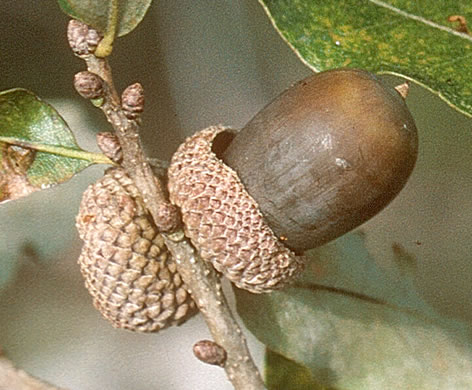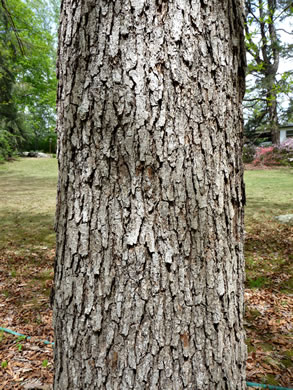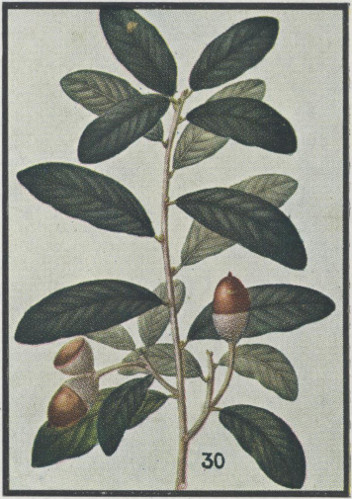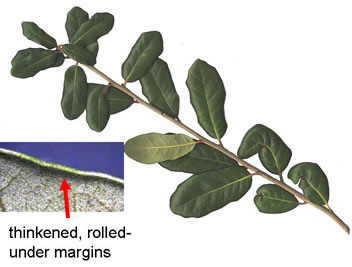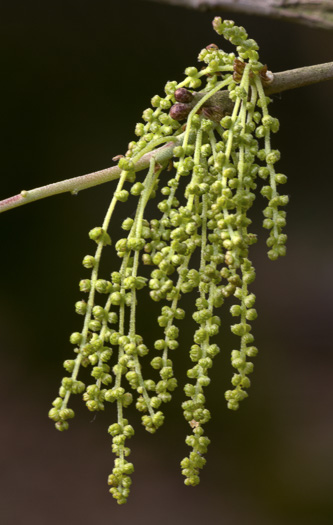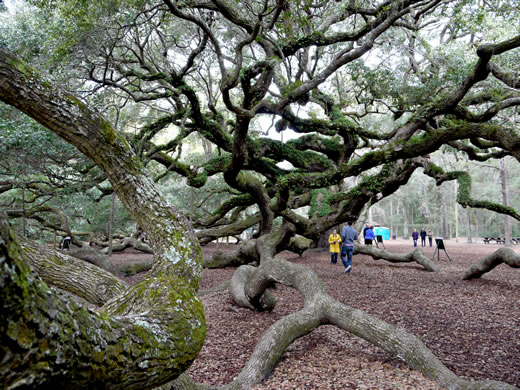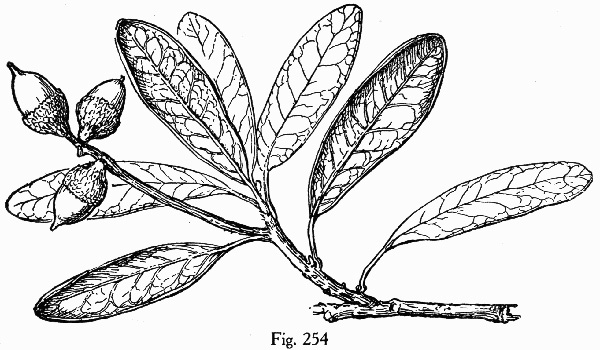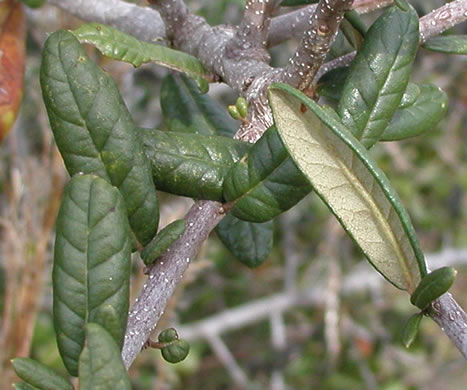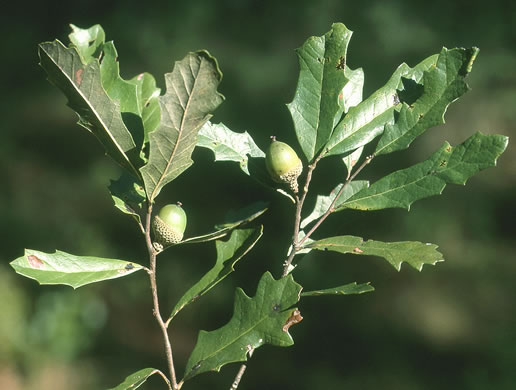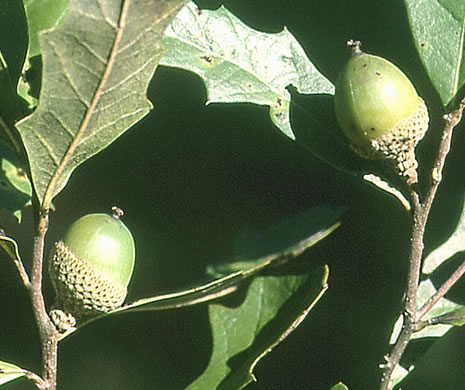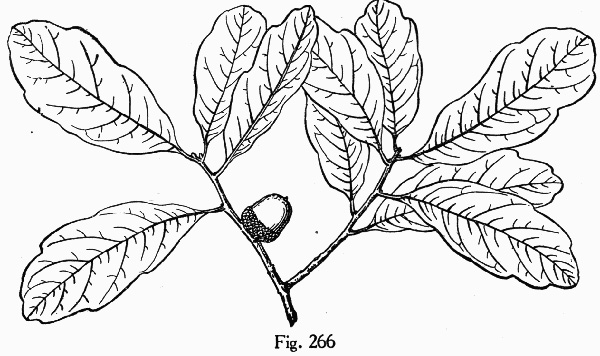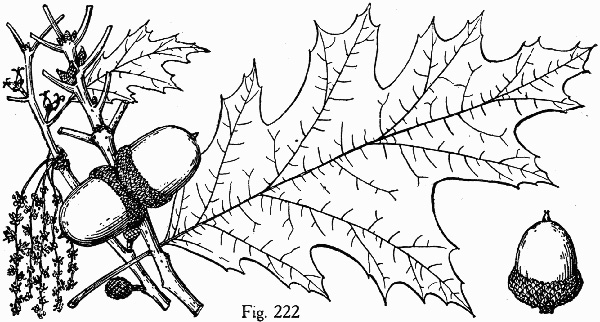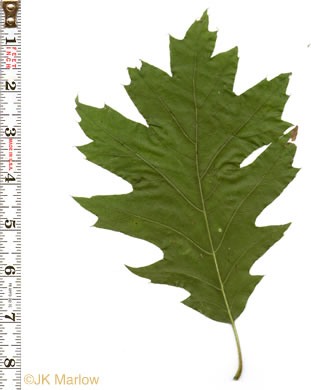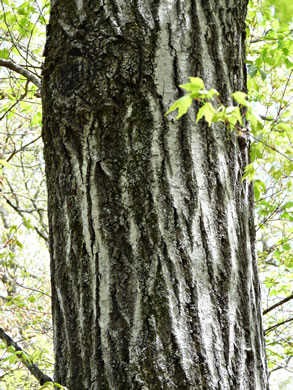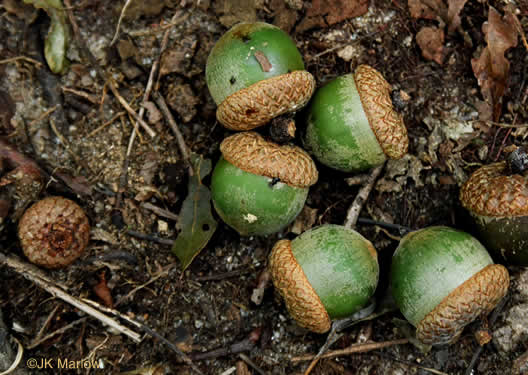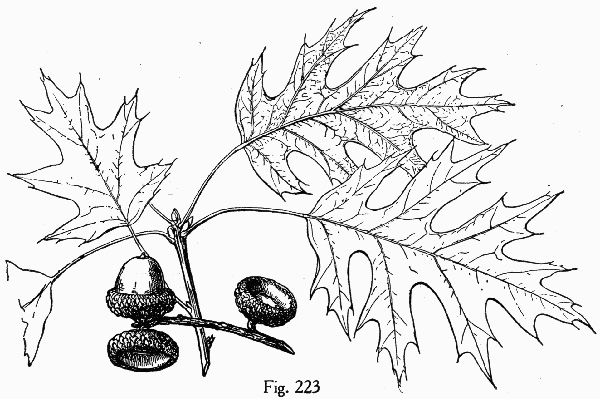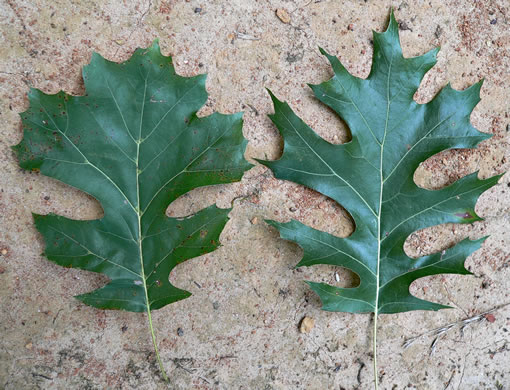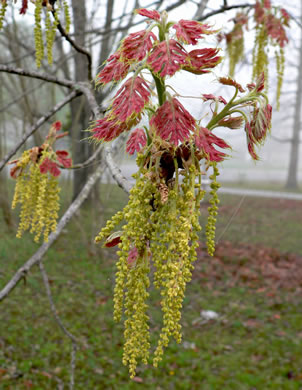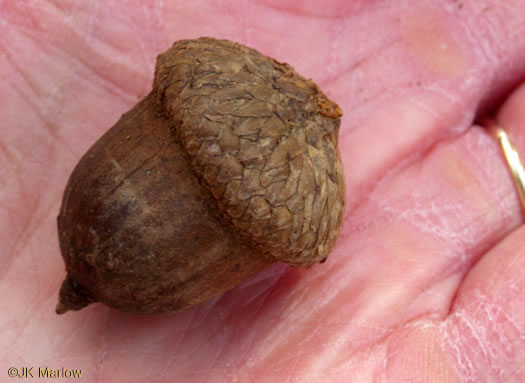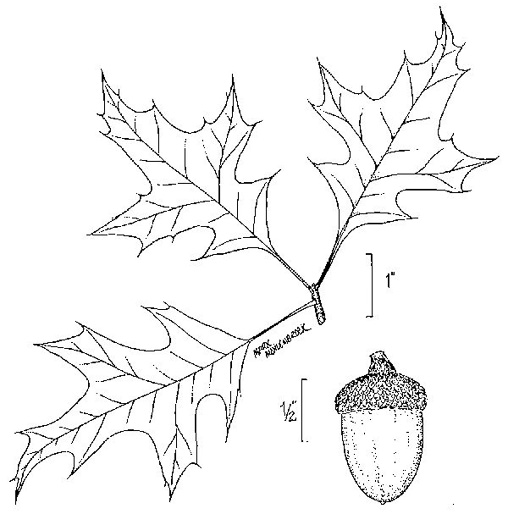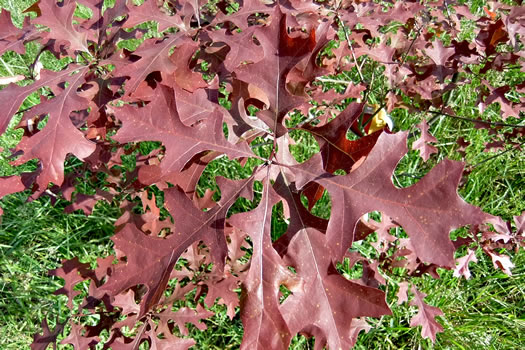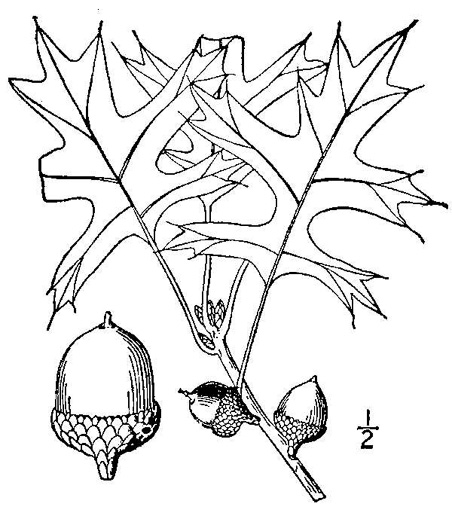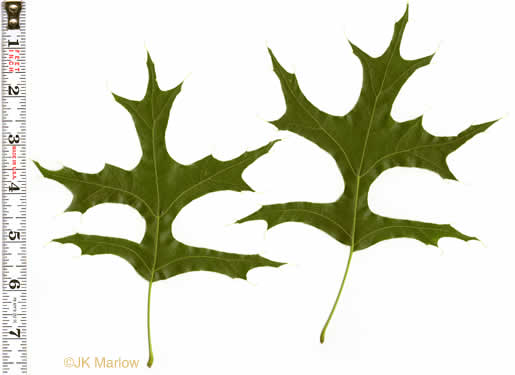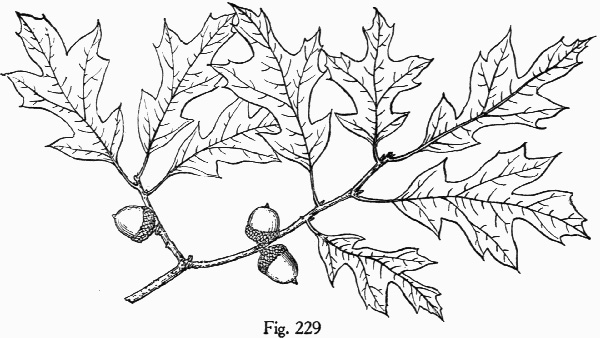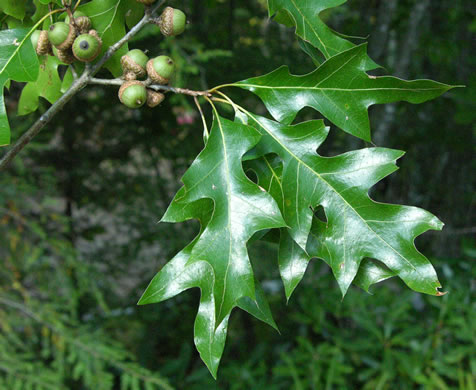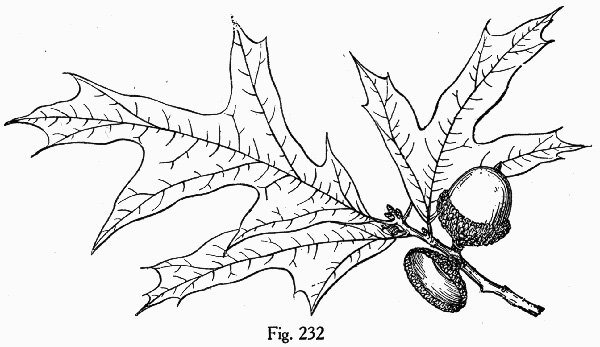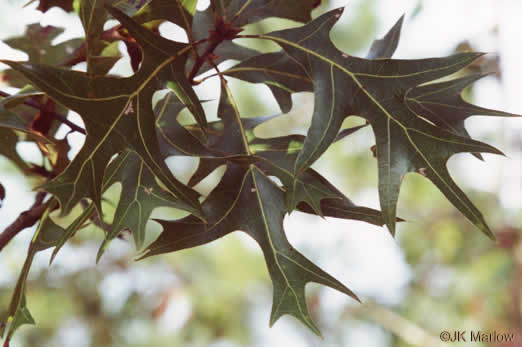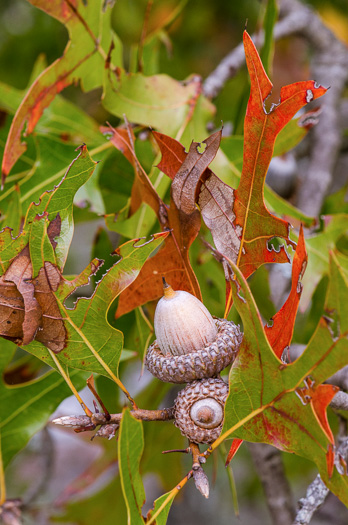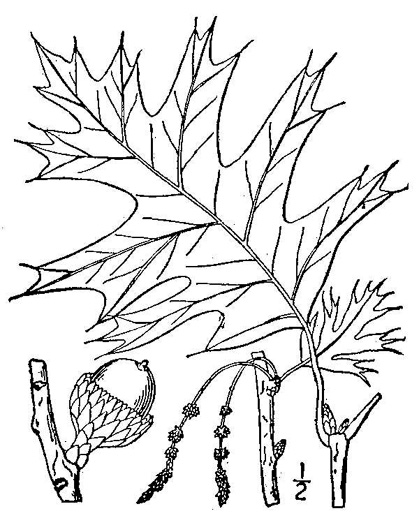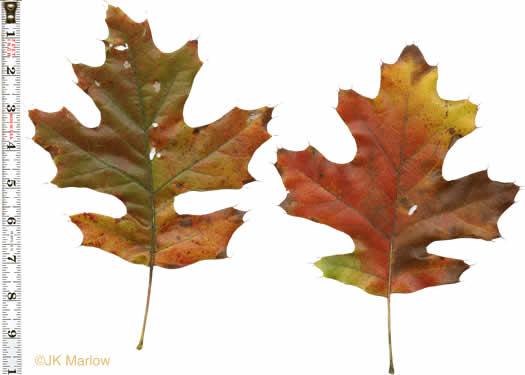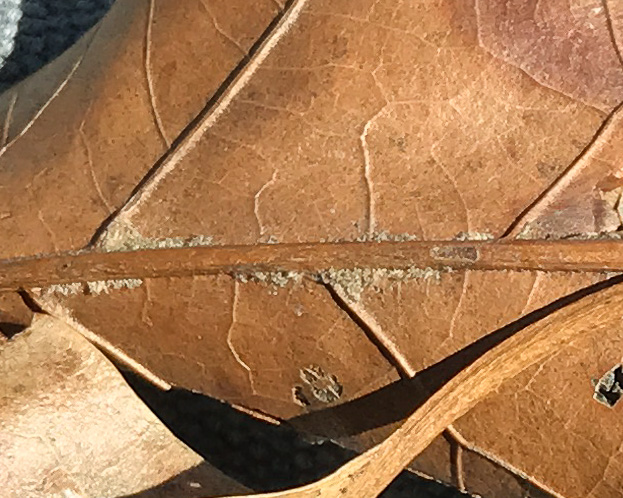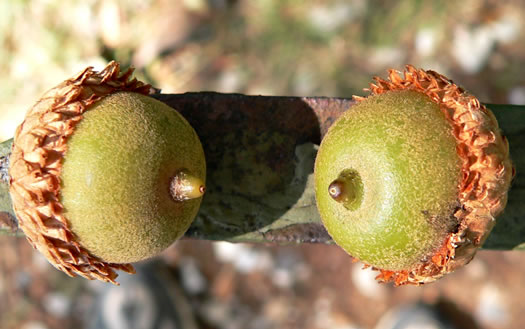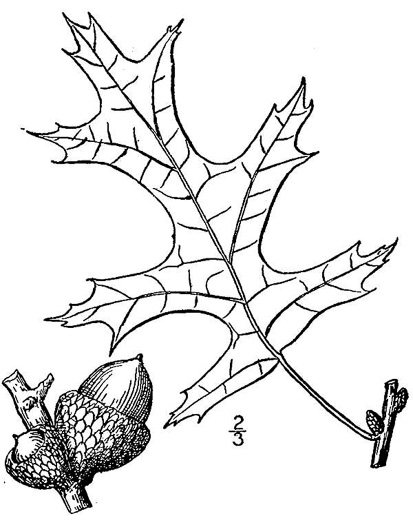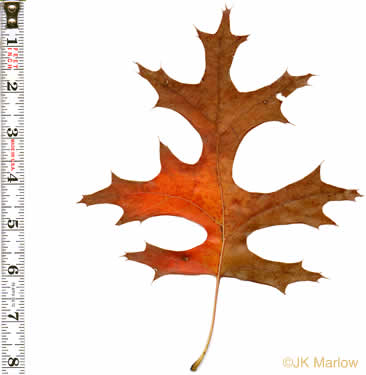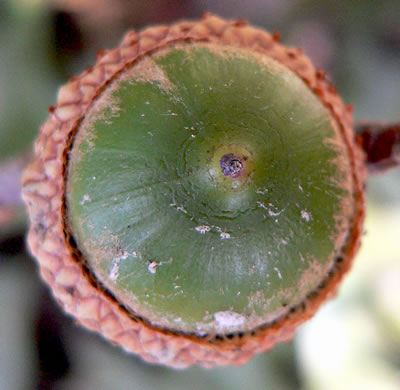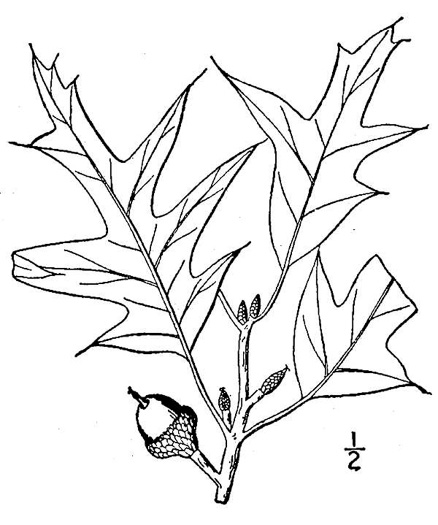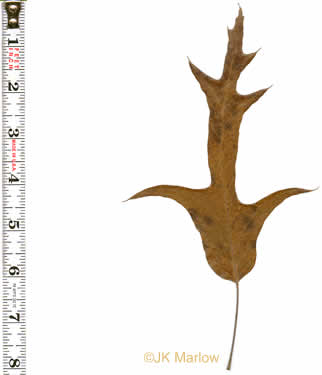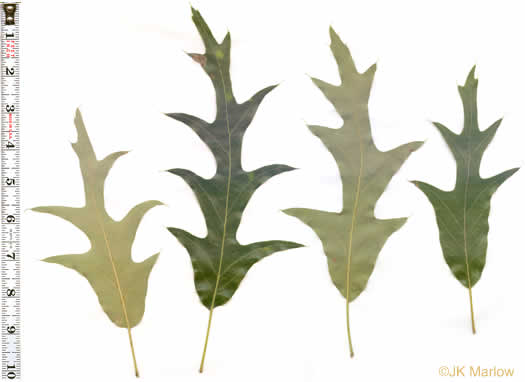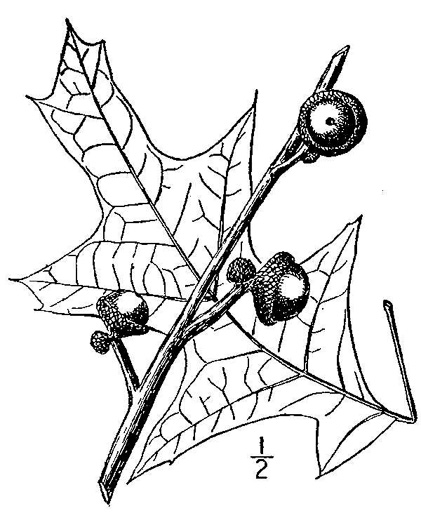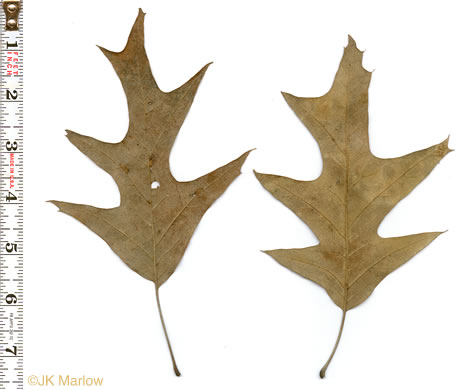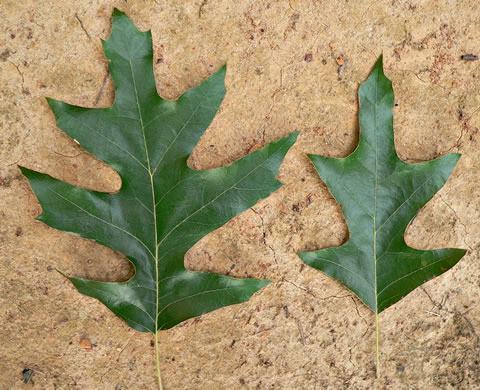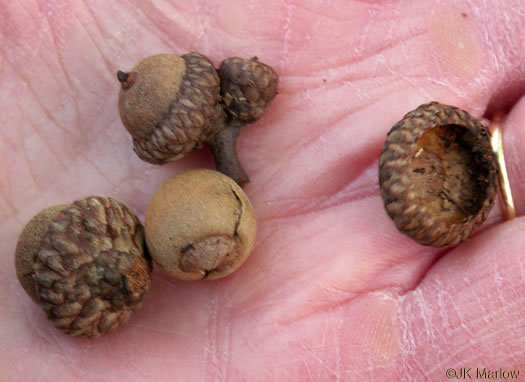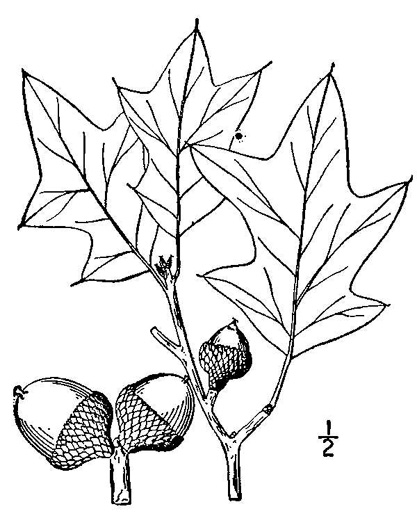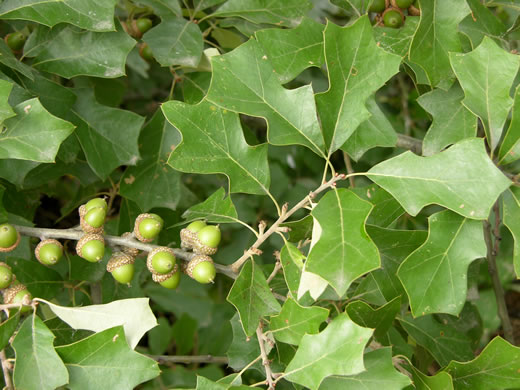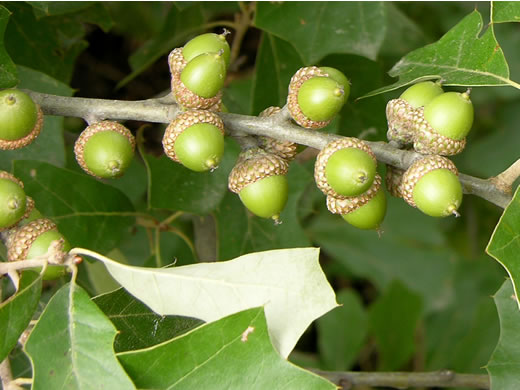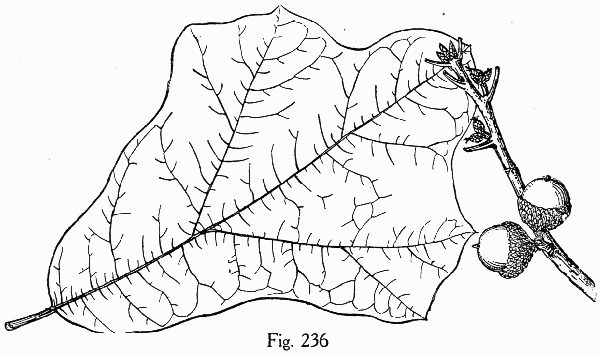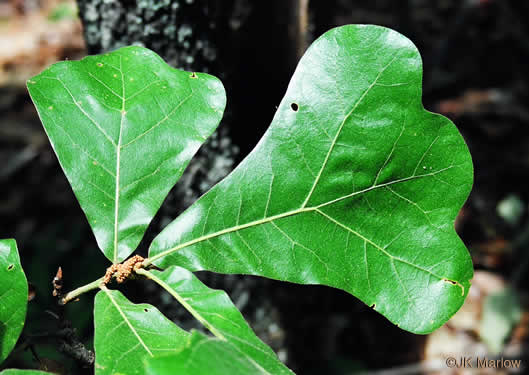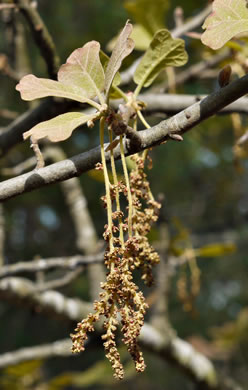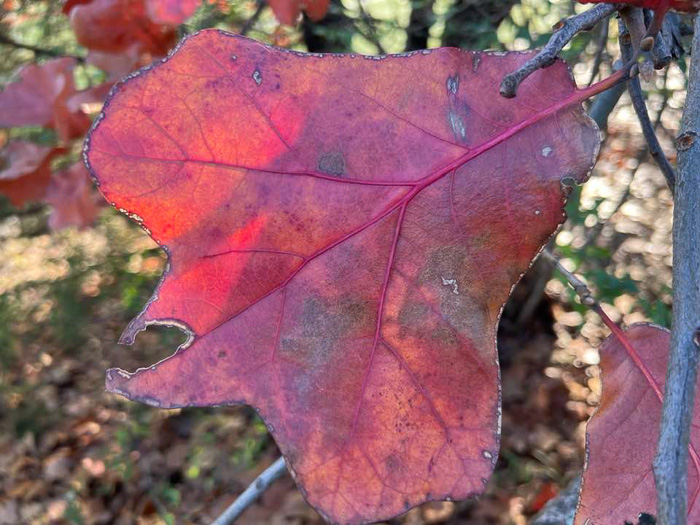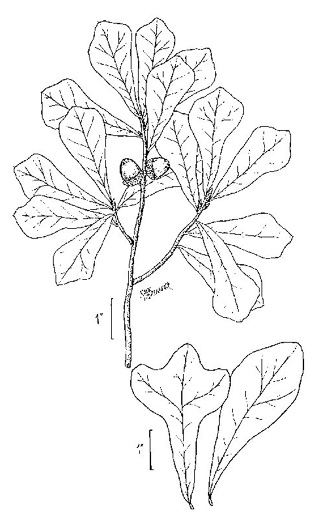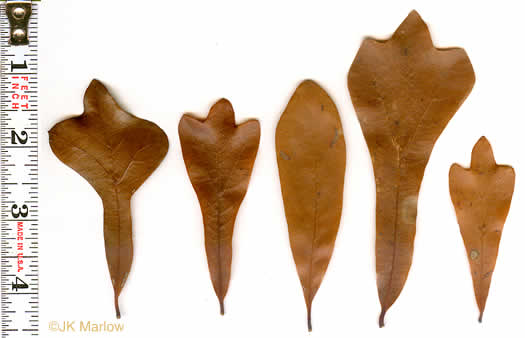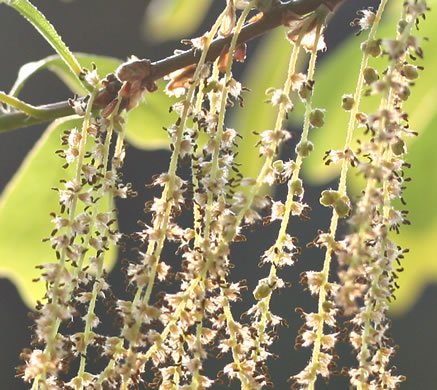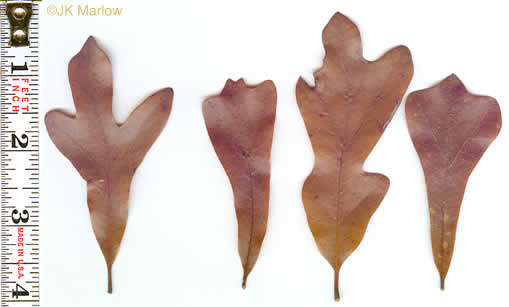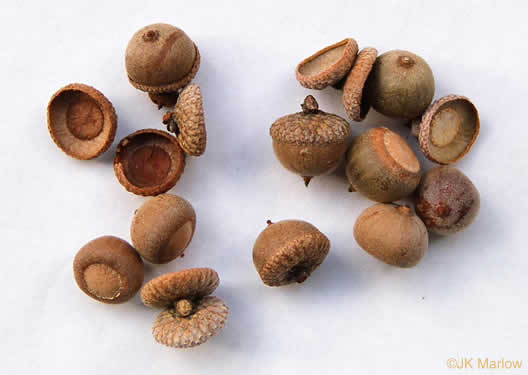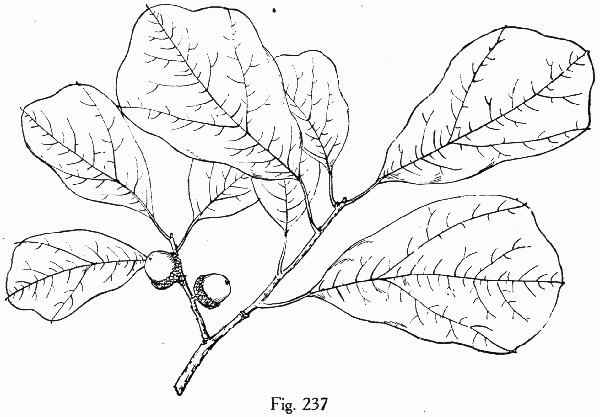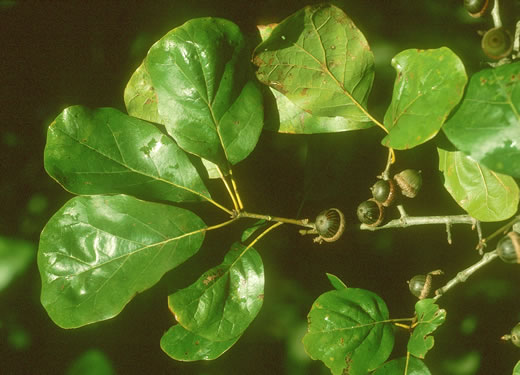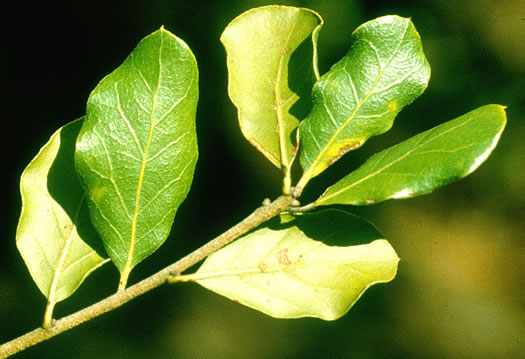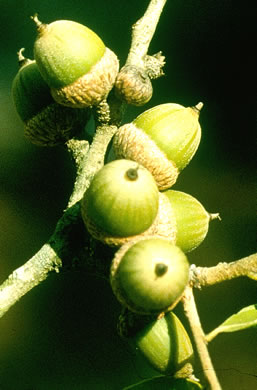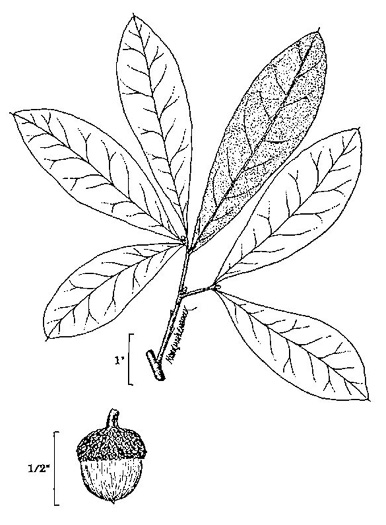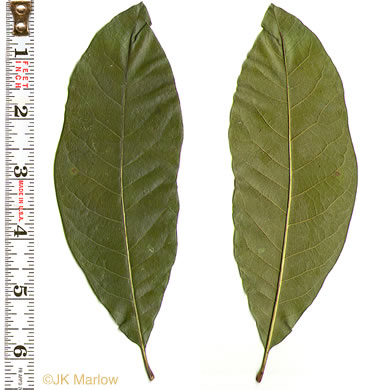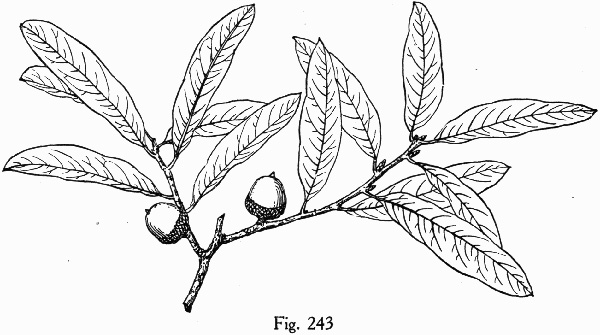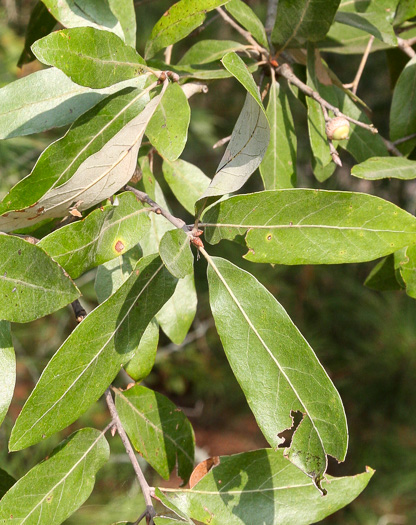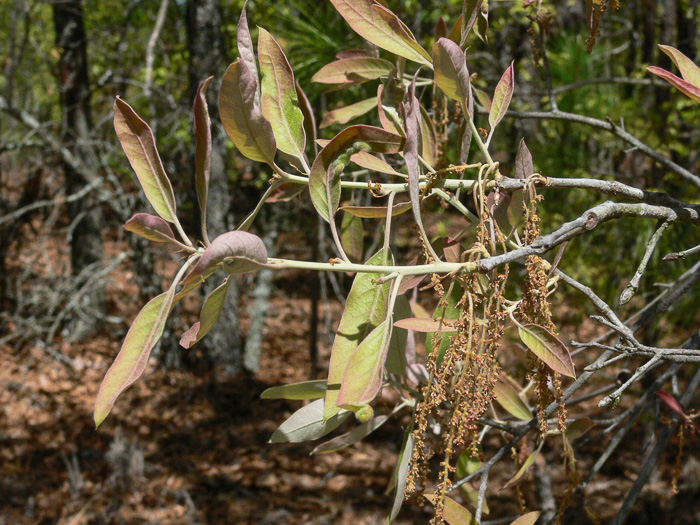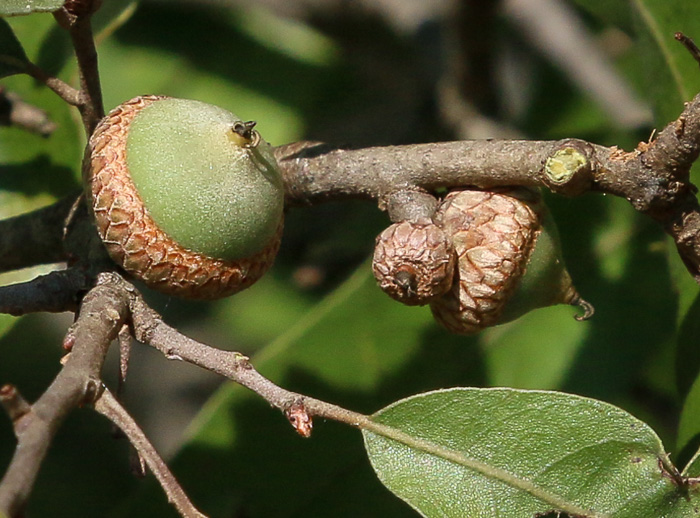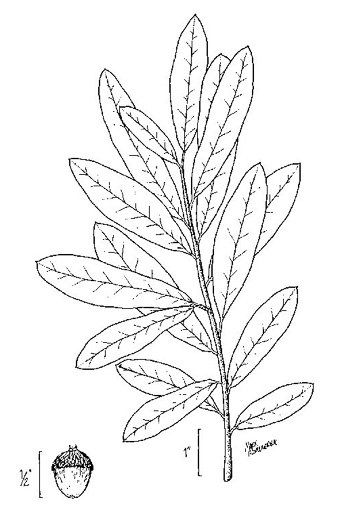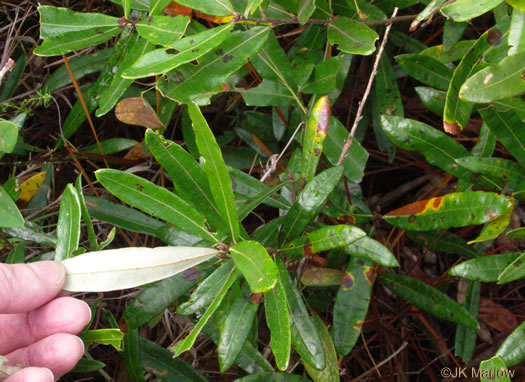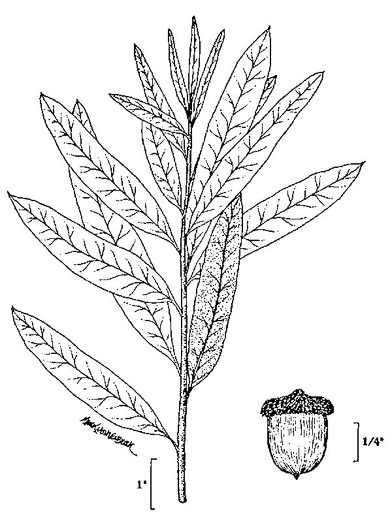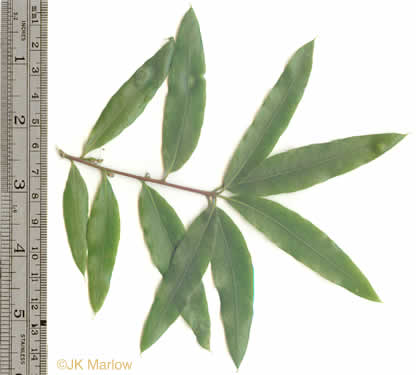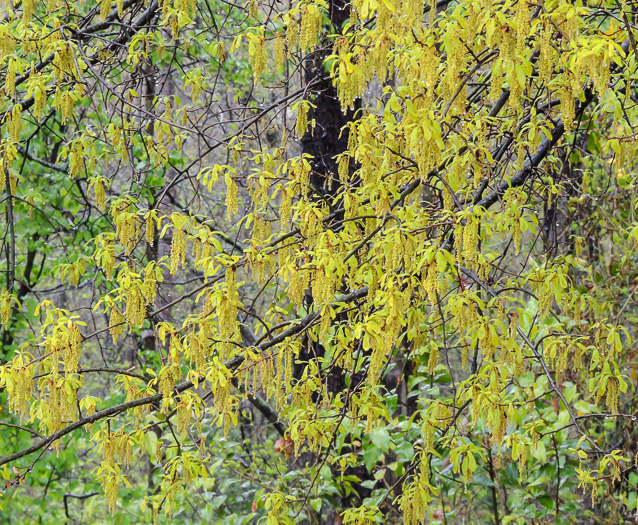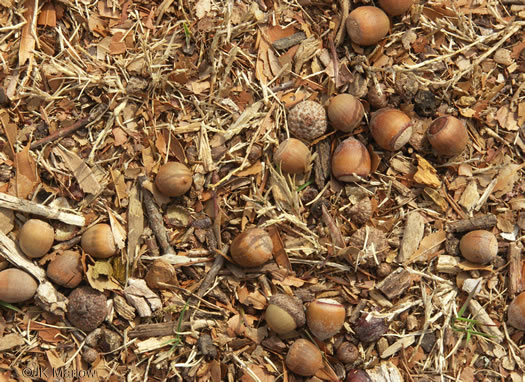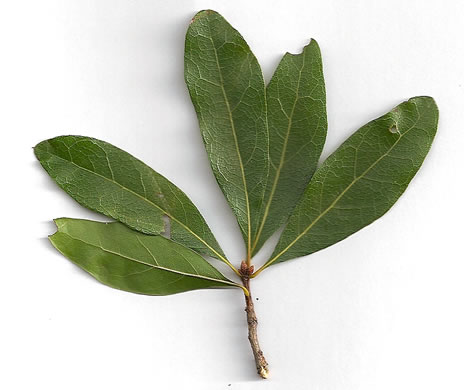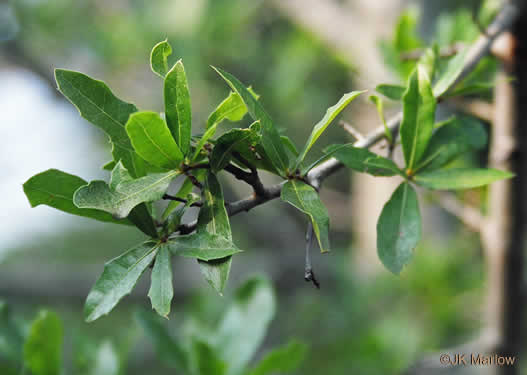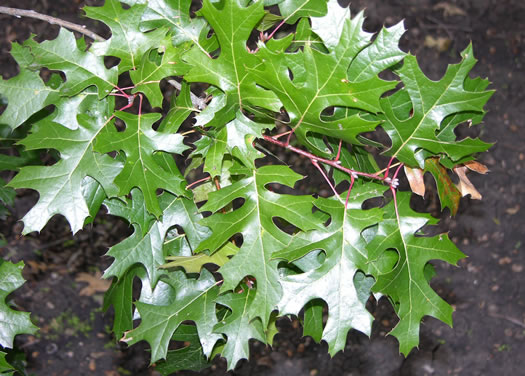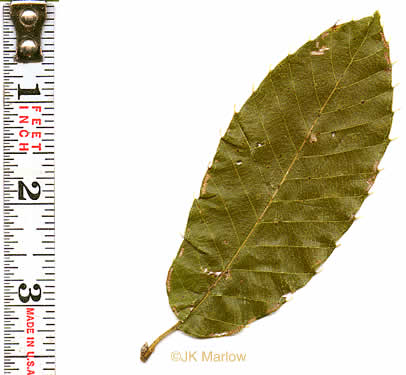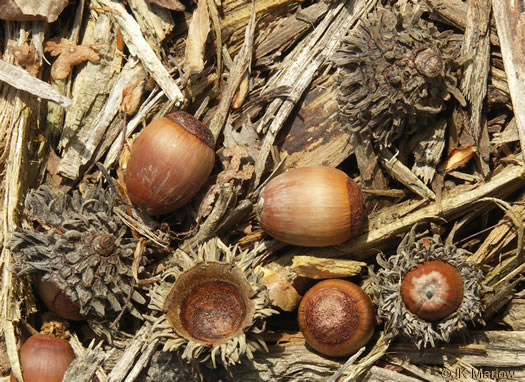Hovering over an image will enlarge it and point out features (works better on desktop than on mobile).
![]() A camera indicates there are pictures.
A camera indicates there are pictures.
![]() A speaker indicates that a botanical name is pronounced.
A speaker indicates that a botanical name is pronounced.
![]() A plus sign after a Latin name indicates that the species is further divided into varieties or subspecies.
A plus sign after a Latin name indicates that the species is further divided into varieties or subspecies.
Most habitat and range descriptions were obtained from Weakley's Flora.
Your search found 50 taxa in the family Fagaceae, Beech family, as understood by Vascular Flora of the Carolinas.

![]()
![]() Common Name:
American Beech
Common Name:
American Beech
Weakley's Flora: (2/10/25) Fagus grandifolia + FAMILY: Fagaceae
INCLUDED WITHIN PLANTS National Database: Fagus grandifolia FAMILY: Fagaceae
INCLUDED WITHIN Vascular Flora of the Carolinas (Radford, Ahles, & Bell, 1968): Fagus grandifolia 055-01-001 FAMILY: Fagaceae
Common
Native to the Carolinas & Georgia

Common Name: European Beech, Copper Beech
Weakley's Flora: (4/14/23) Fagus sylvatica FAMILY: Fagaceae
SYNONYMOUS WITH PLANTS National Database: Fagus sylvatica FAMILY: Fagaceae
Habitat: Rarely cultivated and sometimes long-persistent, but is not known to escape in our region
Non-native: Europe

![]()
![]() Common Name:
American Chestnut
Common Name:
American Chestnut
Weakley's Flora: (4/24/22) Castanea dentata FAMILY: Fagaceae
SYNONYMOUS WITH PLANTS National Database: Castanea dentata FAMILY: Fagaceae
SYNONYMOUS WITH Vascular Flora of the Carolinas (Radford, Ahles, & Bell, 1968): Castanea dentata 055-02-001 FAMILY: Fagaceae
Habitat: Mesic and xeric forests
Common (rare in Coastal Plain)
Native to the Carolinas & Georgia

![]()
![]() Common Name:
Common Chinquapin, Chinkapin, Allegheny Chinquapin
Common Name:
Common Chinquapin, Chinkapin, Allegheny Chinquapin
Weakley's Flora: (4/24/22) Castanea pumila FAMILY: Fagaceae
SYNONYMOUS WITH PLANTS National Database: Castanea pumila var. pumila FAMILY: Fagaceae
INCLUDING Vascular Flora of the Carolinas (Radford, Ahles, & Bell, 1968): Castanea pumila var. pumila 055-02-002 & 003 FAMILY: Fagaceae
Habitat: Xeric forests and woodlands, generally in fire-maintained habitats
Common
Native to the Carolinas & Georgia

![]()
![]() Common Name:
Japanese Chestnut
Common Name:
Japanese Chestnut
Weakley's Flora: (4/24/22) Castanea crenata FAMILY: Fagaceae
SYNONYMOUS WITH PLANTS National Database: Castanea crenata FAMILY: Fagaceae
Habitat: Cultivated, and persisting
Non-native: Japan & Korea

![]()
![]() Common Name:
Chinese Chestnut
Common Name:
Chinese Chestnut
Weakley's Flora: (4/24/22) Castanea mollissima FAMILY: Fagaceae
SYNONYMOUS WITH PLANTS National Database: Castanea mollissima FAMILY: Fagaceae
Habitat: Forests
Rare, widely planted and sometimes naturalizing
Non-native: China

![]()
![]() Common Name:
Spanish Chestnut, European Chestnut
Common Name:
Spanish Chestnut, European Chestnut
Weakley's Flora: (4/14/23) Castanea sativa FAMILY: Fagaceae
SYNONYMOUS WITH PLANTS National Database: Castanea sativa FAMILY: Fagaceae
Habitat: Planted and perhaps locally naturalizing
Waif(s)
Non-native

![]()
![]() Common Name:
White Oak
Common Name:
White Oak
Weakley's Flora: (4/24/22) Quercus alba FAMILY: Fagaceae
SYNONYMOUS WITH PLANTS National Database: Quercus alba FAMILY: Fagaceae
SYNONYMOUS WITH Vascular Flora of the Carolinas (Radford, Ahles, & Bell, 1968): Quercus alba 055-03-001 FAMILY: Fagaceae
Habitat: Mesic to xeric forests
Common
Native to the Carolinas & Georgia

![]()
![]() Common Name:
Post Oak
Common Name:
Post Oak
Weakley's Flora: (4/24/22) Quercus stellata FAMILY: Fagaceae
SYNONYMOUS WITH PLANTS National Database: Quercus stellata FAMILY: Fagaceae
SYNONYMOUS WITH Vascular Flora of the Carolinas (Radford, Ahles, & Bell, 1968): Quercus stellata 055-03-002 FAMILY: Fagaceae
Habitat: Upland forests and woodlands, especially in clay or rocky soils and in communities at least formerly exposed to fire
Common (uncommon in Mountains)
Native to the Carolinas & Georgia

![]()
![]() Common Name:
Boynton Oak, Boynton Sand Post Oak
Common Name:
Boynton Oak, Boynton Sand Post Oak
Weakley's Flora: (4/24/22) Quercus boyntonii FAMILY: Fagaceae
SYNONYMOUS WITH PLANTS National Database: Quercus boyntonii FAMILY: Fagaceae
Habitat: Dry forests
Native: west of the Carolinas & Georgia

![]()
![]() Common Name:
Swamp Post Oak, Bottomland Post Oak, Delta Oak
Common Name:
Swamp Post Oak, Bottomland Post Oak, Delta Oak
Weakley's Flora: (4/24/22) Quercus similis FAMILY: Fagaceae
SYNONYMOUS WITH PLANTS National Database: Quercus similis FAMILY: Fagaceae
Habitat: Hardwood flatwoods and bottomland hardwood forests, especially over calcareous or subcalcareous substrates
Rare
Native to Georgia, South Carolina, & possibly North Carolina

![]() Common Name:
Sand Post Oak, Scrub Post Oak, Margaret's Oak
Common Name:
Sand Post Oak, Scrub Post Oak, Margaret's Oak
Weakley's Flora: (4/24/22) Quercus margaretiae FAMILY: Fagaceae
SYNONYMOUS WITH (ORTHOGRAPHIC VARIANT) PLANTS National Database: Quercus margaretta FAMILY: Fagaceae
SYNONYMOUS WITH Vascular Flora of the Carolinas (Radford, Ahles, & Bell, 1968): Quercus margaretta 055-03-003 FAMILY: Fagaceae
Habitat: Longleaf pine sandhills, typically in slightly loamy or clayey soils, not usual in the deepest and most xeric sands; outside of the distribution of Pinus palustris, in deep sandy, loamy, or rocky sites; also dry bluff forests
Common in Coastal Plain (rare elsewhere)
Native to the Carolinas & Georgia

![]() Common Name:
Bluff Oak, Bastard Oak
Common Name:
Bluff Oak, Bastard Oak
Weakley's Flora: (4/24/22) Quercus austrina FAMILY: Fagaceae
SYNONYMOUS WITH PLANTS National Database: Quercus austrina FAMILY: Fagaceae
SYNONYMOUS WITH Vascular Flora of the Carolinas (Radford, Ahles, & Bell, 1968): Quercus austrina 055-03-004 FAMILY: Fagaceae
Habitat: River bluffs, mesic hammocks, dry hammocks, natural levees of brownwater rivers, over mafic rocks, on shell or calcareous sediments
Rare
Native to the Carolinas & Georgia

![]()
![]() Common Name:
Overcup Oak
Common Name:
Overcup Oak
Weakley's Flora: (4/24/22) Quercus lyrata FAMILY: Fagaceae
SYNONYMOUS WITH PLANTS National Database: Quercus lyrata FAMILY: Fagaceae
SYNONYMOUS WITH Vascular Flora of the Carolinas (Radford, Ahles, & Bell, 1968): Quercus lyrata 055-03-005 FAMILY: Fagaceae
Habitat: Seasonally rather deeply and frequently flooded soils of floodplains of the Coastal Plain, less commonly in seasonally flooded swamps in Triassic basins in the lower Piedmont, and rarely in upland depression swamps of the Piedmont (developed over clays weathered from mafic rocks) and Coastal Plain. Of our oaks, Q. lyrata tolerates the wettest habitats, both in terms of depth and duration of flooding
Common in Coastal Plain (uncommon in Piedmont, rare in Mountains)
Native to the Carolinas & Georgia

![]()
![]() Common Name:
Bur Oak, Mossycup Oak
Common Name:
Bur Oak, Mossycup Oak
Weakley's Flora: (4/24/22) Quercus macrocarpa var. macrocarpa FAMILY: Fagaceae
SYNONYMOUS WITH PLANTS National Database: Quercus macrocarpa var. macrocarpa FAMILY: Fagaceae
Habitat: Rich bottomland forests, sometimes in drier forests, woodlands, oak savannas, and prairie edges, and then usually over limestone or other calcareous rocks
Waif(s)
Native: north & west of the Carolinas & Georgia

![]()
![]() Common Name:
Swamp White Oak
Common Name:
Swamp White Oak
Weakley's Flora: (4/24/22) Quercus bicolor FAMILY: Fagaceae
SYNONYMOUS WITH PLANTS National Database: Quercus bicolor FAMILY: Fagaceae
SYNONYMOUS WITH Vascular Flora of the Carolinas (Radford, Ahles, & Bell, 1968): Quercus bicolor 055-03-006 FAMILY: Fagaceae
Habitat: Bottomland swamps and wet forests with calcareous sediments, upland depression swamp forests over mafic rocks such as gabbro or diabase
Rare
Native to the Carolinas

![]()
![]() Common Name:
Swamp Chestnut Oak, Basket Oak
Common Name:
Swamp Chestnut Oak, Basket Oak
Weakley's Flora: (4/24/22) Quercus michauxii FAMILY: Fagaceae
SYNONYMOUS WITH PLANTS National Database: Quercus michauxii FAMILY: Fagaceae
SYNONYMOUS WITH Vascular Flora of the Carolinas (Radford, Ahles, & Bell, 1968): Quercus michauxii 055-03-007 FAMILY: Fagaceae
Habitat: Bottomland forests, especially in fertile soils of upper terraces where flooded only infrequently and for short periods, upland depression ponds, sometimes on moist lower slopes
Common (rare in Mountains)
Native to the Carolinas & Georgia

![]()
![]() Common Name:
Rock Chestnut Oak, Mountain Oak, Tanbark Oak
Common Name:
Rock Chestnut Oak, Mountain Oak, Tanbark Oak
Weakley's Flora: (4/24/22) Quercus montana FAMILY: Fagaceae
SYNONYMOUS WITH PLANTS National Database: Quercus montana FAMILY: Fagaceae
SYNONYMOUS WITH (NAME REJECTED, PROBABLY MISAPPLIED & A SOURCE OF CONFUSION) Vascular Flora of the Carolinas (Radford, Ahles, & Bell, 1968): Quercus prinus 055-03-008 FAMILY: Fagaceae
Habitat: Xeric forests of ridges and slopes, shale barrens, occasionally in mesic situations especially where rocky
Common (rare in Coastal Plain)
Native to the Carolinas & Georgia

![]()
![]() Common Name:
Chinquapin Oak, Yellow Chestnut Oak, Yellow Oak
Common Name:
Chinquapin Oak, Yellow Chestnut Oak, Yellow Oak
Weakley's Flora: (4/24/22) Quercus muehlenbergii FAMILY: Fagaceae
SYNONYMOUS WITH PLANTS National Database: Quercus muehlenbergii FAMILY: Fagaceae
SYNONYMOUS WITH Vascular Flora of the Carolinas (Radford, Ahles, & Bell, 1968): Quercus muehlenbergii 055-03-009 FAMILY: Fagaceae
Habitat: Slopes and bluffs, on soils derived from calcareous or mafic rocks
Uncommon (rare in SC Coastal Plain)
Native to the Carolinas & Georgia

![]()
![]() Common Name:
Dwarf Chinquapin Oak
Common Name:
Dwarf Chinquapin Oak
Weakley's Flora: (4/24/22) Quercus prinoides FAMILY: Fagaceae
SYNONYMOUS WITH PLANTS National Database: Quercus prinoides FAMILY: Fagaceae
SYNONYMOUS WITH Vascular Flora of the Carolinas (Radford, Ahles, & Bell, 1968): Quercus prinoides 055-03-010 FAMILY: Fagaceae
Habitat: Xeric upland glades, barrens, and woodlands, on clay soils derived from mafic, ultramafic, or calcareous rocks or in sandy acidic soils, generally in sites which naturally burned rather frequently
Rare
Native to the Carolinas & Georgia

Common Name: Durand Oak
Weakley's Flora: (4/24/22) Quercus durandii var. durandii FAMILY: Fagaceae
SYNONYMOUS WITH PLANTS National Database: Quercus sinuata var. sinuata FAMILY: Fagaceae
INCLUDING Vascular Flora of the Carolinas (Radford, Ahles, & Bell, 1968): Quercus durandii 055-03-011 FAMILY: Fagaceae
Habitat: Calcareous bluffs, glades, prairies, ravines, hardwood flatwoods, bottomland forests
Rare
Native to South Carolina & Georgia

![]()
![]() Common Name:
Bigelow Oak
Common Name:
Bigelow Oak
Weakley's Flora: (4/24/22) Quercus durandii var. breviloba FAMILY: Fagaceae
SYNONYMOUS WITH PLANTS National Database: Quercus sinuata var. breviloba FAMILY: Fagaceae
Habitat: Limestone outcrops, rocky areas; calcareous prairies
Native: Western US

![]() Common Name:
Oglethorpe Oak
Common Name:
Oglethorpe Oak
Weakley's Flora: (4/24/22) Quercus oglethorpensis FAMILY: Fagaceae
SYNONYMOUS WITH PLANTS National Database: Quercus oglethorpensis FAMILY: Fagaceae
SYNONYMOUS WITH Vascular Flora of the Carolinas (Radford, Ahles, & Bell, 1968): Quercus oglethorpensis 055-03-012 FAMILY: Fagaceae
Habitat: Bottomland forests, upland oak flats over clays (Iredell and Enon soils)
Rare
Native to South Carolina & Georgia

![]()
![]() Common Name:
Live Oak, Southern Live Oak
Common Name:
Live Oak, Southern Live Oak
Weakley's Flora: (4/24/22) Quercus virginiana FAMILY: Fagaceae
SYNONYMOUS WITH PLANTS National Database: Quercus virginiana FAMILY: Fagaceae
INCLUDED WITHIN Vascular Flora of the Carolinas (Radford, Ahles, & Bell, 1968): Quercus virginiana 055-03-013 FAMILY: Fagaceae
Habitat: Locally common to abundant in maritime forests and maritime scrub on barrier islands, more rarely inland (though regularly on the mainland from se. NC south, and extending substantially inland from s. SC south), sometimes in dry, fire-maintained habitats more usually occupied by Q. geminata, also planted (especially in the outer Coastal Plain)
Common in Coastal Plain
Native to the Carolinas & Georgia

![]() Common Name:
Sand Live Oak
Common Name:
Sand Live Oak
Weakley's Flora: (4/24/22) Quercus geminata FAMILY: Fagaceae
SYNONYMOUS WITH PLANTS National Database: Quercus geminata FAMILY: Fagaceae
INCLUDED WITHIN Vascular Flora of the Carolinas (Radford, Ahles, & Bell, 1968): Quercus virginiana 055-03-013? FAMILY: Fagaceae
Habitat: Xeric sandhills (northward restricted to areas very near the coast), Florida scrub (especially yellow sands), coastal dry hammocks
Common in GA Coastal Plain (uncommon in Carolinas)
Native to the Carolinas & Georgia

![]()
![]() Common Name:
Dwarf Live Oak
Common Name:
Dwarf Live Oak
Weakley's Flora: (4/24/22) Quercus minima FAMILY: Fagaceae
SYNONYMOUS WITH PLANTS National Database: Quercus minima FAMILY: Fagaceae
Habitat: Florida dry prairies, dry to wet pine flatwoods, coastal fringe sandhills, pine rocklands
Common in GA Coastal Plain (uncommon in SC, rare in NC)
Native to the Carolinas & Georgia

Common Name: Chapman Oak
Weakley's Flora: (4/24/22) Quercus chapmanii FAMILY: Fagaceae
SYNONYMOUS WITH PLANTS National Database: Quercus chapmanii FAMILY: Fagaceae
SYNONYMOUS WITH Vascular Flora of the Carolinas (Radford, Ahles, & Bell, 1968): Quercus chapmanii 055-03-014 FAMILY: Fagaceae
Habitat: Dry pinelands, longleaf sandhills, scrubby flatwoods, Florida scrub (more abundant often on white sands)
Rare
Native to South Carolina & Georgia

![]() Common Name:
Northern Red Oak
Common Name:
Northern Red Oak
Weakley's Flora: (2/10/25) Quercus rubra + FAMILY: Fagaceae
INCLUDED WITHIN PLANTS National Database: Quercus rubra FAMILY: Fagaceae
Vascular Flora of the Carolinas (Radford, Ahles, & Bell, 1968): Quercus rubra + 055-03-015 FAMILY: Fagaceae
Look for it forests of slopes, coves, and - depending upon variety - ridges or ravines
Common, uncommon, rare, or absent - depending on variety & region
Native to the Carolinas & Georgia

![]()
![]() Common Name:
Shumard Oak, Swamp Red Oak
Common Name:
Shumard Oak, Swamp Red Oak
Weakley's Flora: (4/14/23) Quercus shumardii FAMILY: Fagaceae
INCLUDING PLANTS National Database: Quercus shumardii var. shumardii FAMILY: Fagaceae
SYNONYMOUS WITH Vascular Flora of the Carolinas (Radford, Ahles, & Bell, 1968): Quercus shumardii 055-03-016 FAMILY: Fagaceae
Habitat: Moist and fertile soils of bottomlands and moist slopes, also in xeric sites over calcareous rocks (such as limestone)
Common in NC Piedmont (rare in Mountains; rare in Coastal Plain of GA & SC) (uncommon elsewhere in GA-NC-SC)
Native to the Carolinas & Georgia

![]() Common Name:
Nuttall Oak, Texas Red Oak
Common Name:
Nuttall Oak, Texas Red Oak
Weakley's Flora: (4/14/23) Quercus texana FAMILY: Fagaceae
SYNONYMOUS WITH PLANTS National Database: Quercus texana FAMILY: Fagaceae
Habitat: Bottomland hardwood forests, hardwood flatwoods, swamps, also now widely planted well east of its native distribution
Native west of the Carolinas & Georgia

![]()
![]() Common Name:
Pin Oak
Common Name:
Pin Oak
Weakley's Flora: (4/24/22) Quercus palustris FAMILY: Fagaceae
SYNONYMOUS WITH PLANTS National Database: Quercus palustris FAMILY: Fagaceae
SYNONYMOUS WITH Vascular Flora of the Carolinas (Radford, Ahles, & Bell, 1968): Quercus palustris 055-03-017 FAMILY: Fagaceae
Habitat: Hardwood flatwoods, bottomland forests, swamps, sinkhole ponds, sloughs, wet prairies, upland sag ponds; also widely planted as a street tree in towns and cities
Rare south of VA
Native to North Carolina

![]()
![]() Common Name:
Georgia Oak
Common Name:
Georgia Oak
Weakley's Flora: (4/24/22) Quercus georgiana FAMILY: Fagaceae
SYNONYMOUS WITH PLANTS National Database: Quercus georgiana FAMILY: Fagaceae
SYNONYMOUS WITH Vascular Flora of the Carolinas (Radford, Ahles, & Bell, 1968): Quercus georgiana 055-03-018 FAMILY: Fagaceae
Habitat: Dry slopes, ridges, and bluffs, mainly over granite and quartzite
Uncommon in GA Piedmont (rare elsewhere in GA-NC-SC)
Native to the Carolinas & Georgia

![]()
![]() Common Name:
Turkey Oak
Common Name:
Turkey Oak
Weakley's Flora: (4/24/22) Quercus laevis FAMILY: Fagaceae
SYNONYMOUS WITH PLANTS National Database: Quercus laevis FAMILY: Fagaceae
SYNONYMOUS WITH Vascular Flora of the Carolinas (Radford, Ahles, & Bell, 1968): Quercus laevis 055-03-019 FAMILY: Fagaceae
Habitat: Longleaf pine sandhills, primarily in very xeric soils of deep sandy deposits (Carolina bay rims, old beach dunes, early Cenozoic deposits of the Fall-line Sandhills), or inland from the Coastal Plain on dry ridges and slopes over quartzite or other acidic rock types
Common in Coastal Plain (rare in Piedmont)
Native to the Carolinas & Georgia

![]()
![]() Common Name:
Black Oak
Common Name:
Black Oak
Weakley's Flora: (4/24/22) Quercus velutina FAMILY: Fagaceae
SYNONYMOUS WITH PLANTS National Database: Quercus velutina FAMILY: Fagaceae
SYNONYMOUS WITH Vascular Flora of the Carolinas (Radford, Ahles, & Bell, 1968): Quercus velutina 055-03-020 FAMILY: Fagaceae
Habitat: Upland forests and woodlands, especially in fairly xeric and sandy soils
Common
Native to the Carolinas & Georgia

![]()
![]() Common Name:
Scarlet Oak
Common Name:
Scarlet Oak
Weakley's Flora: (4/14/23) Quercus coccinea FAMILY: Fagaceae
SYNONYMOUS WITH PLANTS National Database: Quercus coccinea FAMILY: Fagaceae
SYNONYMOUS WITH Vascular Flora of the Carolinas (Radford, Ahles, & Bell, 1968): Quercus coccinea 055-03-021 FAMILY: Fagaceae
Habitat: Xeric upland forests
Common (uncommon in Carolina Coastal Plain) (rare in GA Coastal Plain)
Native to the Carolinas & Georgia

![]()
![]() Common Name:
Southern Red Oak, Spanish Oak
Common Name:
Southern Red Oak, Spanish Oak
Weakley's Flora: (4/14/23) Quercus falcata FAMILY: Fagaceae
SYNONYMOUS WITH PLANTS National Database: Quercus falcata FAMILY: Fagaceae
SYNONYMOUS WITH Vascular Flora of the Carolinas (Radford, Ahles, & Bell, 1968): Quercus falcata var. falcata 055-03-022a FAMILY: Fagaceae
Habitat: Upland forests, usually xeric or submesic, but occasionally in mesic situations
Common (uncommon in NC Mountains)
Native to the Carolinas & Georgia

![]()
![]() Common Name:
Cherrybark Oak, Swamp Spanish Oak
Common Name:
Cherrybark Oak, Swamp Spanish Oak
Weakley's Flora: (4/14/23) Quercus pagoda FAMILY: Fagaceae
SYNONYMOUS WITH PLANTS National Database: Quercus pagoda FAMILY: Fagaceae
SYNONYMOUS WITH Vascular Flora of the Carolinas (Radford, Ahles, & Bell, 1968): Quercus falcata var. pagodaefolia 055-03-022b FAMILY: Fagaceae
Habitat: Bottomland forests, especially on second terraces, also mesic to dry-mesic upland sites, especially where somewhat base-rich
Common in Coastal Plain (rare elsewhere in GA-NC-SC)
Native to the Carolinas & Georgia

![]()
![]() Common Name:
Bear Oak, Scrub Oak
Common Name:
Bear Oak, Scrub Oak
Weakley's Flora: (4/24/22) Quercus ilicifolia FAMILY: Fagaceae
SYNONYMOUS WITH PLANTS National Database: Quercus ilicifolia FAMILY: Fagaceae
SYNONYMOUS WITH Vascular Flora of the Carolinas (Radford, Ahles, & Bell, 1968): Quercus ilicifolia 055-03-023 FAMILY: Fagaceae
Habitat: Xeric soils in ridges in the Mountains and monadnocks in the upper Piedmont, pine-oak / heath woodlands, shale barrens, other dry and acidic sites
Rare in NC
Native to North Carolina

![]()
![]() Common Name:
Blackjack Oak
Common Name:
Blackjack Oak
Weakley's Flora: (4/24/22) Quercus marilandica var. marilandica FAMILY: Fagaceae
SYNONYMOUS WITH PLANTS National Database: Quercus marilandica var. marilandica FAMILY: Fagaceae
INCLUDED WITHIN Vascular Flora of the Carolinas (Radford, Ahles, & Bell, 1968): Quercus marilandica 055-03-024 FAMILY: Fagaceae
Habitat: Upland forests and woodlands, usually on periodically droughty soils, as over shrink-swell clays, sandstones, deep sands, sands with clay lenses, and shallow soils over acidic bedrock
Common (uncommon in Mountains)
Native to the Carolinas & Georgia

![]()
![]() Common Name:
Water Oak, Paddle Oak
Common Name:
Water Oak, Paddle Oak
Weakley's Flora: (4/24/22) Quercus nigra FAMILY: Fagaceae
SYNONYMOUS WITH PLANTS National Database: Quercus nigra FAMILY: Fagaceae
SYNONYMOUS WITH Vascular Flora of the Carolinas (Radford, Ahles, & Bell, 1968): Quercus nigra 055-03-025 FAMILY: Fagaceae
Habitat: Bottomland forests, especially on levees or second terraces where flooded infrequently and for short periods, less commonly on mesic slopes, but also now widely distributed and common as a "weed tree" in upland situations
Common (rare in Mountains)
Native to the Carolinas & Georgia

![]()
![]() Common Name:
Arkansas Oak
Common Name:
Arkansas Oak
Weakley's Flora: (4/24/22) Quercus arkansana FAMILY: Fagaceae
SYNONYMOUS WITH PLANTS National Database: Quercus arkansana FAMILY: Fagaceae
Habitat: Dry bluffs
Rare
Native to Georgia

![]()
![]() Common Name:
Myrtle Oak
Common Name:
Myrtle Oak
Weakley's Flora: (4/24/22) Quercus myrtifolia FAMILY: Fagaceae
SYNONYMOUS WITH PLANTS National Database: Quercus myrtifolia FAMILY: Fagaceae
SYNONYMOUS WITH Vascular Flora of the Carolinas (Radford, Ahles, & Bell, 1968): Quercus myrtifolia 055-03-026 FAMILY: Fagaceae
Habitat: Longleaf pine sandhills, Florida scrub (more commonly on yellow sands), oak scrub, dry flatwoods, coastal dunes
Uncommon in GA, rare in SC
Native to South Carolina & Georgia

![]()
![]() Common Name:
Shingle Oak
Common Name:
Shingle Oak
Weakley's Flora: (4/24/22) Quercus imbricaria FAMILY: Fagaceae
SYNONYMOUS WITH PLANTS National Database: Quercus imbricaria FAMILY: Fagaceae
SYNONYMOUS WITH Vascular Flora of the Carolinas (Radford, Ahles, & Bell, 1968): Quercus imbricaria 055-03-027 FAMILY: Fagaceae
Habitat: Rich soils of upper floodplains of rivers and creeks, often at the base of the slope into the upland, also on lower slopes, upland depression swamps, and in drier forests over diabase, limestone, or other calcareous or mafic claypan soils, rarely extending to 5100 feet elevation
Uncommon in NC Mountains (rare elsewhere in GA-NC-SC)
Native to North Carolina & Georgia

![]() Common Name:
Bluejack Oak
Common Name:
Bluejack Oak
Weakley's Flora: (4/24/22) Quercus incana FAMILY: Fagaceae
SYNONYMOUS WITH PLANTS National Database: Quercus incana FAMILY: Fagaceae
SYNONYMOUS WITH Vascular Flora of the Carolinas (Radford, Ahles, & Bell, 1968): Quercus incana 055-03-028 FAMILY: Fagaceae
Habitat: Sandhills, primarily in somewhat loamier textured, submesic soils, inland from the Coastal Plain on coarse sandy alluvium or upland ridges over quartzite or other acidic rocks
Common in Coastal Plain (rare in Piedmont)
Native to the Carolinas & Georgia

![]() Common Name:
Running Oak
Common Name:
Running Oak
Weakley's Flora: (4/24/22) Quercus elliottii FAMILY: Fagaceae
SYNONYMOUS WITH (MISAPPLIED) PLANTS National Database: Quercus pumila FAMILY: Fagaceae
SYNONYMOUS WITH (MISAPPLIED) Vascular Flora of the Carolinas (Radford, Ahles, & Bell, 1968): Quercus pumila 055-03-029 FAMILY: Fagaceae
Habitat: Mesic pine savannas, especially on loamy soils in the Middle Coastal Plain, pine rocklands
Common in GA Coastal Plain (uncommon in SC, rare in NC)
Native to the Carolinas & Georgia

![]()
![]() Common Name:
Willow Oak, "Pin Oak"
Common Name:
Willow Oak, "Pin Oak"
Weakley's Flora: (4/24/22) Quercus phellos FAMILY: Fagaceae
SYNONYMOUS WITH PLANTS National Database: Quercus phellos FAMILY: Fagaceae
SYNONYMOUS WITH Vascular Flora of the Carolinas (Radford, Ahles, & Bell, 1968): Quercus phellos 055-03-030 FAMILY: Fagaceae
Habitat: Bottomland forests, especially on natural levees and second terraces, also in upland depression swamps developed on clay soils and in upland clay hardpan situations, weedy and successional on slopes and upland sites as a "weed tree" following disturbance, and widely planted as a street tree in towns and cities
Common in Coastal Plain, uncommon in Piedmont, uncommon to rare in Mountains
Native to the Carolinas & Georgia

![]()
![]() Common Name:
Laurel Oak, Swamp Laurel Oak, Diamond Leaf Oak
Common Name:
Laurel Oak, Swamp Laurel Oak, Diamond Leaf Oak
Weakley's Flora: (4/24/22) Quercus laurifolia FAMILY: Fagaceae
SYNONYMOUS WITH PLANTS National Database: Quercus laurifolia FAMILY: Fagaceae
INCLUDED WITHIN Vascular Flora of the Carolinas (Radford, Ahles, & Bell, 1968): Quercus laurifolia 055-03-031 FAMILY: Fagaceae
Habitat: Mesic to seasonally flooded soils of floodplains, also (rarely) mesic slopes and swamps in maritime forests
Common in Coastal Plain (rare in Piedmont)
Native to the Carolinas & Georgia

![]()
![]() Common Name:
Darlington Oak, Sand Laurel Oak
Common Name:
Darlington Oak, Sand Laurel Oak
Weakley's Flora: (4/14/23) Quercus hemisphaerica FAMILY: Fagaceae
SYNONYMOUS WITH PLANTS National Database: Quercus hemisphaerica FAMILY: Fagaceae
INCLUDED WITHIN Vascular Flora of the Carolinas (Radford, Ahles, & Bell, 1968): Quercus laurifolia 055-03-031? FAMILY: Fagaceae
Habitat: Longleaf pine sandhills, dry hammocks, and other dry, sandy soils, a component of maritime forests with Q. virginiana, and widely planted as a street tree in most parts of our region
Common in Coastal Plain (rare in Piedmont)
Native to the Carolinas & Georgia

![]()
![]() Common Name:
Buckley's Oak
Common Name:
Buckley's Oak
Weakley's Flora: (4/24/22) Quercus buckleyi FAMILY: Fagaceae
SYNONYMOUS WITH PLANTS National Database: Quercus buckleyi FAMILY: Fagaceae
Habitat: Woodlands and forests over calcareous rocks
Native: Western US

![]()
![]() Common Name:
Sawtooth Oak
Common Name:
Sawtooth Oak
Weakley's Flora: (4/14/23) Quercus acutissima FAMILY: Fagaceae
SYNONYMOUS WITH PLANTS National Database: Quercus acutissima FAMILY: Fagaceae
Habitat: Commonly cultivated as a suburban street tree and also widely planted in ‘wildlife food plots’, rarely naturalizing
Rare
Non-native: Japan
Your search found 50 taxa. You are on page PAGE 1 out of 1 pages.

